81 Creative and Cool Summer Activities for Active Kids
Summer provides endless opportunities for children to explore and learn.
Engaging outdoor activities during this season combine fun with educational value.
These creative projects encourage physical development, scientific findings, artistic expression, and social interaction.
They help keep kids active and entertained during the warm weather months.
From water play and nature exploration to crafts and experiences, each activity sparks the interest.
Parents and educators can easily adapt these ideas to suit different age groups, available materials, and outdoor spaces.
This ensures memorable summer experiences that promote learning through play.
Summer is an ideal season for preschool learning, as it offers numerous opportunities for hands-on exploration, outdoor play, and natural findings.
With longer daylight hours and warmer weather, children can engage in physical activities that support motor development and social skills.
Nature becomes a classroom, fostering curiosity about science, plants, animals, and the environment.
Unstructured time fosters creativity, while planned activities reinforce early literacy, math, and sensory skills.
Whether through water play, gardening, or outdoor art, summer makes learning joyful, active, and memorable for preschool-aged children.
Maximizing summer activities needs planning, safety, and flexibility to adapt to children’s interests.
Document experiences through photos and journals to create lasting memories and track development.
Involve children in the selection and preparation of activities to increase enthusiasm and ownership.
Encourage reflection after activities to reinforce learning concepts and social skills development.
Balance structured activities with free play time to support natural creativity and independence.
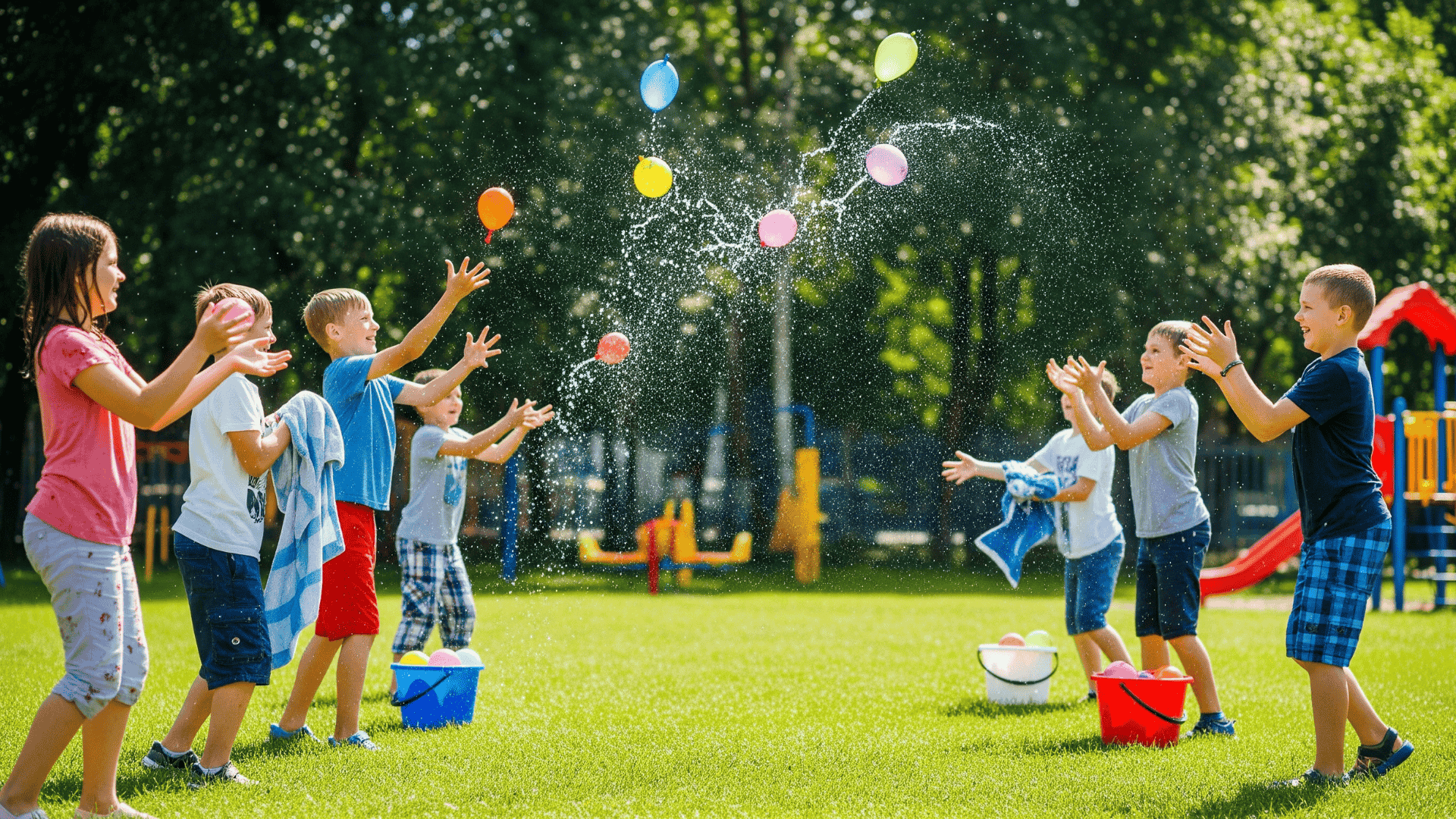
Children pair up and toss colorful water balloons back and forth, stepping back after each catch.
This summer activity improves hand-eye coordination and offers relief from the heat.
Water balloons, water source, and towels.
Fill the balloons with water and have pairs toss them gently while stepping back.

This outdoor activity promotes environmental observation, classification skills, and appreciation for nature.
Children learn to identify textures, colors, and shapes around them.
Printed scavenger hunt lists, collection bags, pencils.
Provide lists and bags, then guide children to find each item safely.
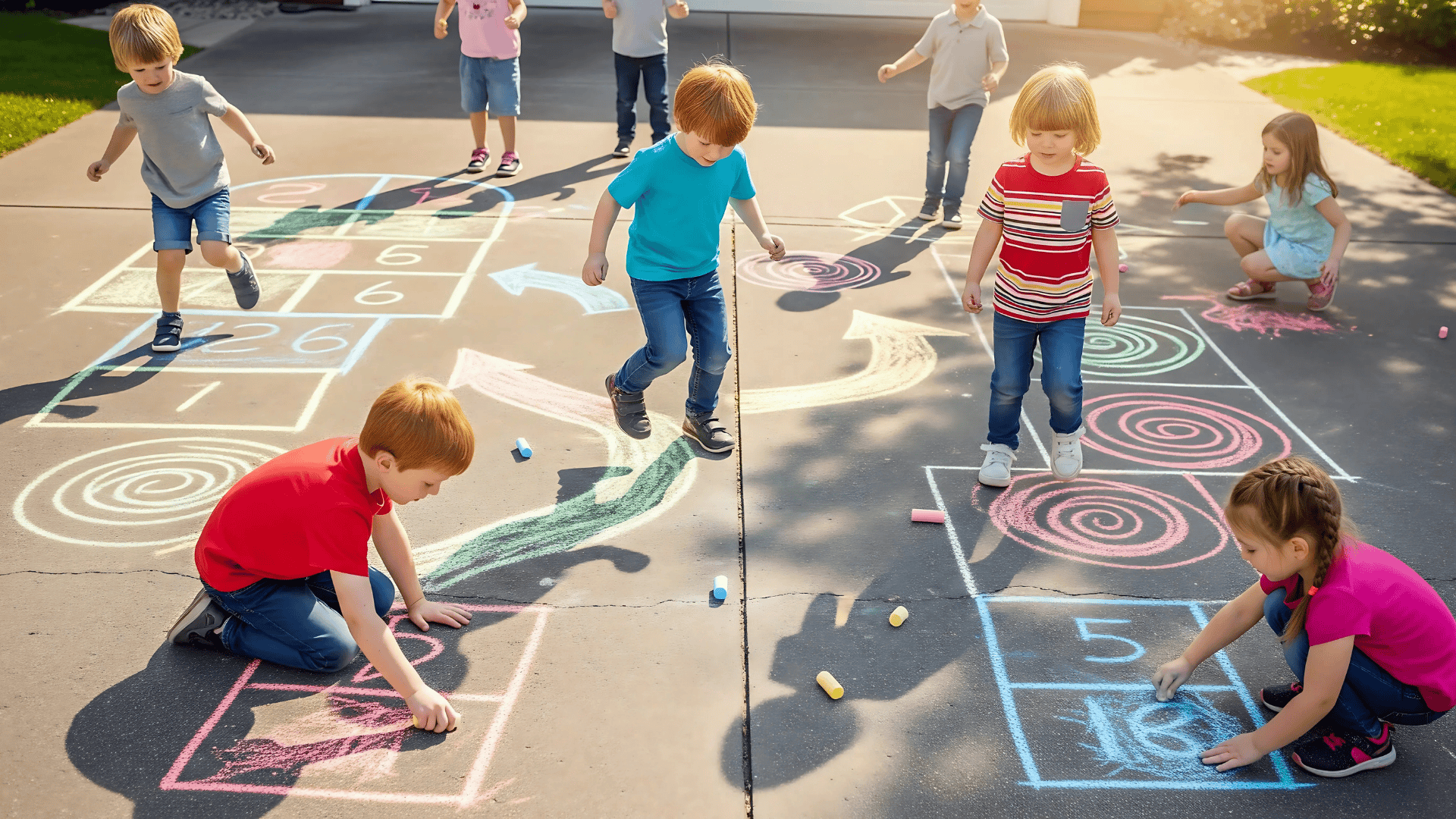
Create an exciting path with bright sidewalk chalk, including hopscotch, zigzags, jumping circles, and arrows for direction.
This activity combines art and movement, allowing children to create or follow pre-drawn courses.
Sidewalk chalk, flat paved area.
Draw various shapes and paths, then demonstrate how to steer the course.
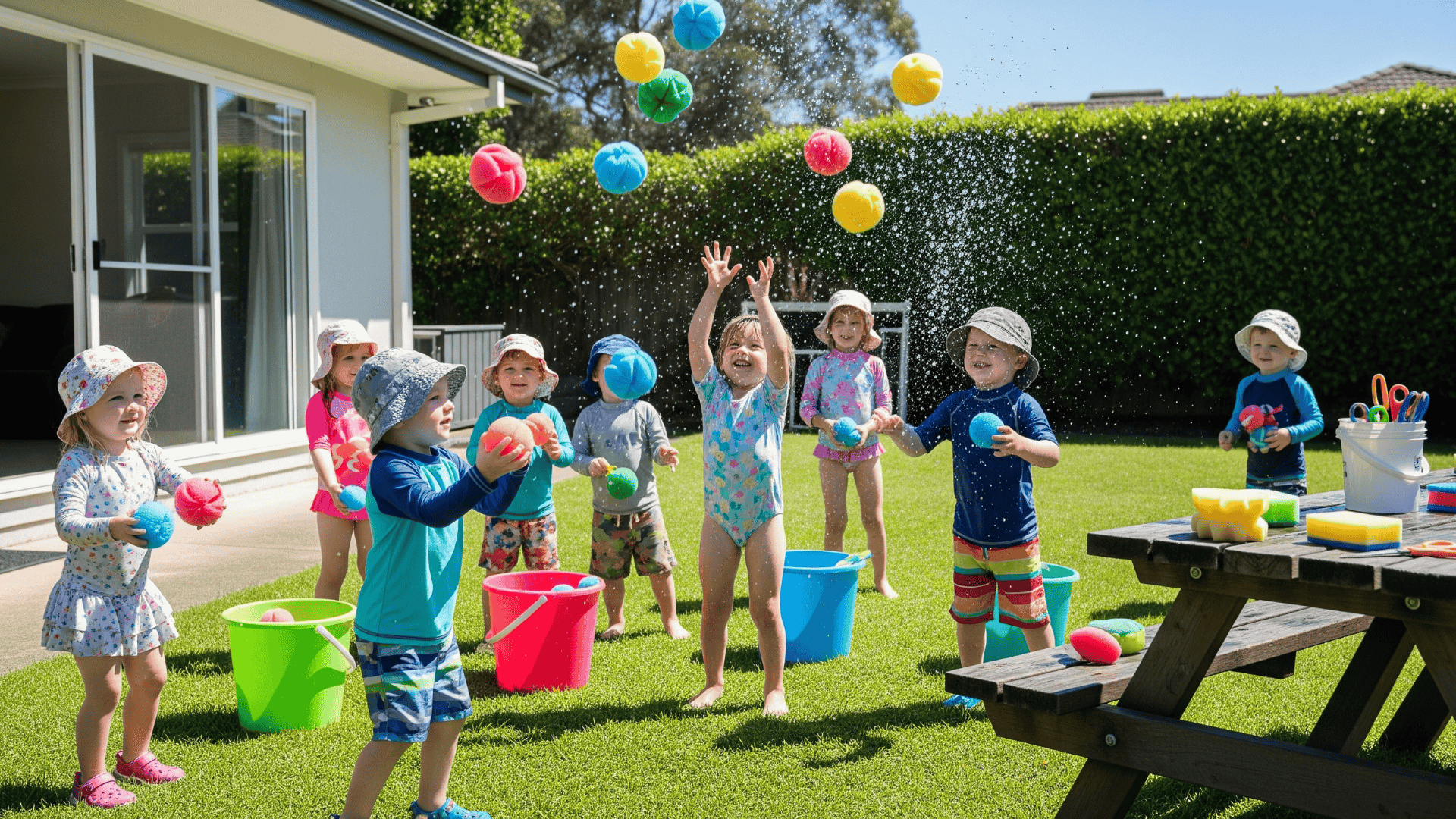
Change kitchen sponges into reusable water toys by cutting them into strips and securing them with rubber bands to create fluffy, absorbent projectiles.
Children can soak them in buckets and engage in gentle water battles.
Kitchen sponges, rubber bands, scissors, water buckets.
Cut sponges into strips, bundle with rubber bands, then soak and toss.
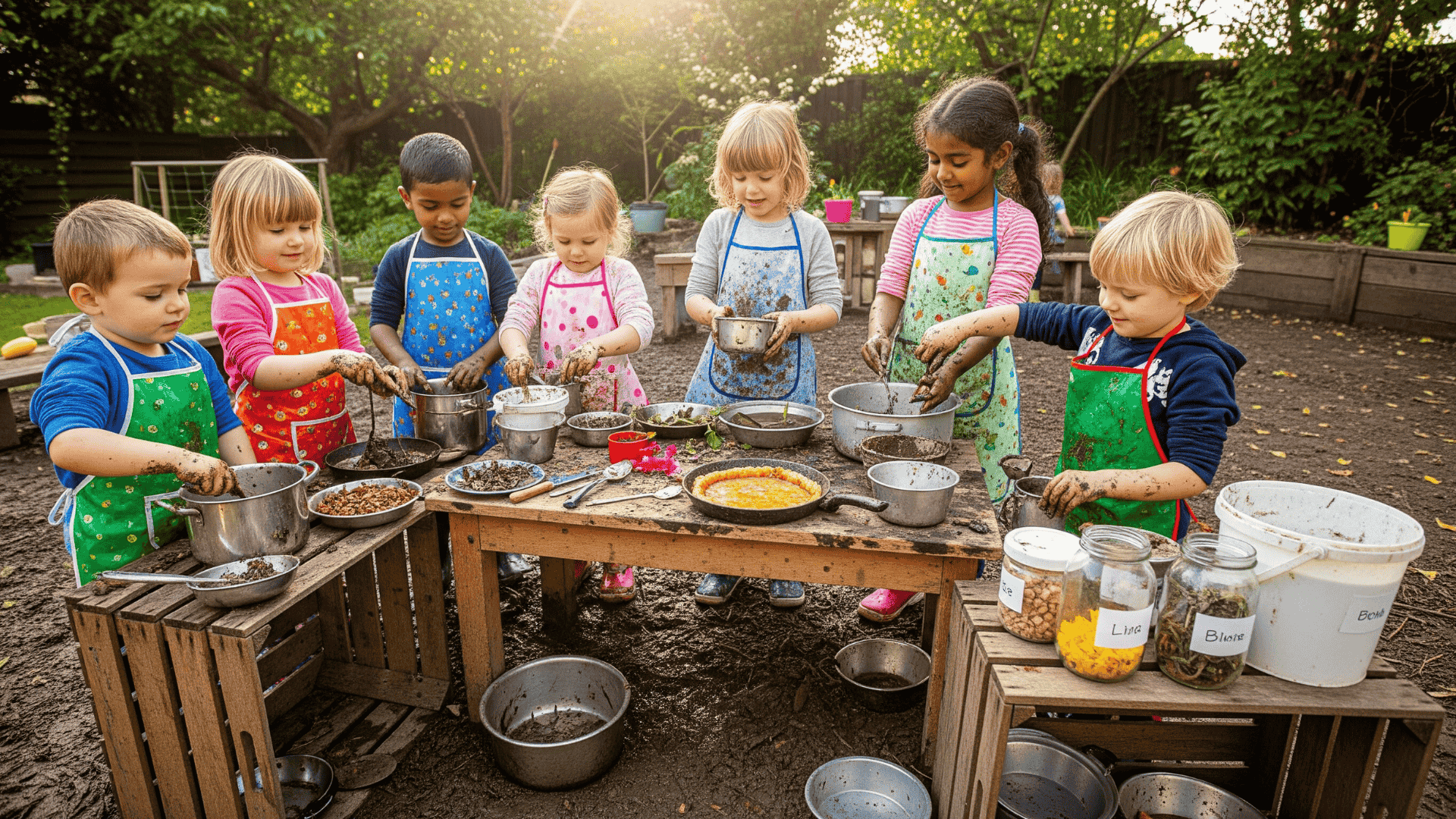
Set up an outdoor cooking station with old pots, pans, utensils, and natural ingredients like dirt, water, leaves, and flowers for creative culinary experiences.
This messy play activity encourages kids to make mud pies and nature soups, fostering creativity, social skills, and sensory exploration.
Old cookware, dirt, water, natural materials, and aprons.
Arrange cooking supplies and let children create their own mud recipes freely.

Mix tempera paint with bubble solution, blow bubbles onto paper, and create artistic impressions as they pop.
This art technique merges science and creativity, teaching kids about surface tension and creating beautiful, unpredictable patterns.
Bubble solution, tempera paint, straws, paper, smocks.
Mix paint with bubble solution and blow bubbles directly onto paper.
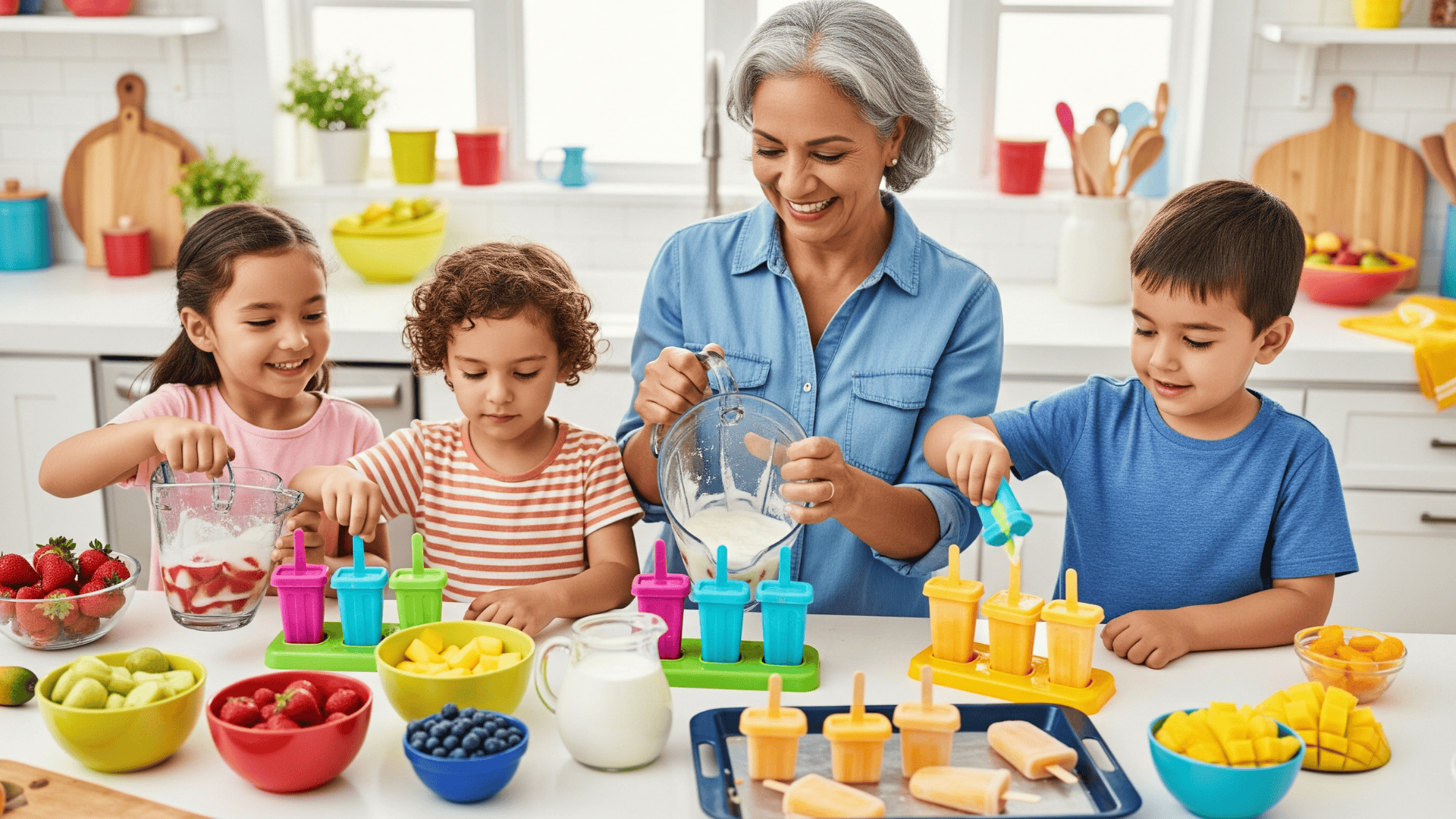
Blend fruits with juice or yogurt, pour into molds, and freeze for a few hours to make healthy, tasty frozen treats.
This cooking activity teaches kitchen skills, promotes healthy eating, and encourages creativity with flavors.
Fruit, juice, popsicle molds, and a blender.
Blend ingredients, pour into molds, insert sticks, and freeze until solid.
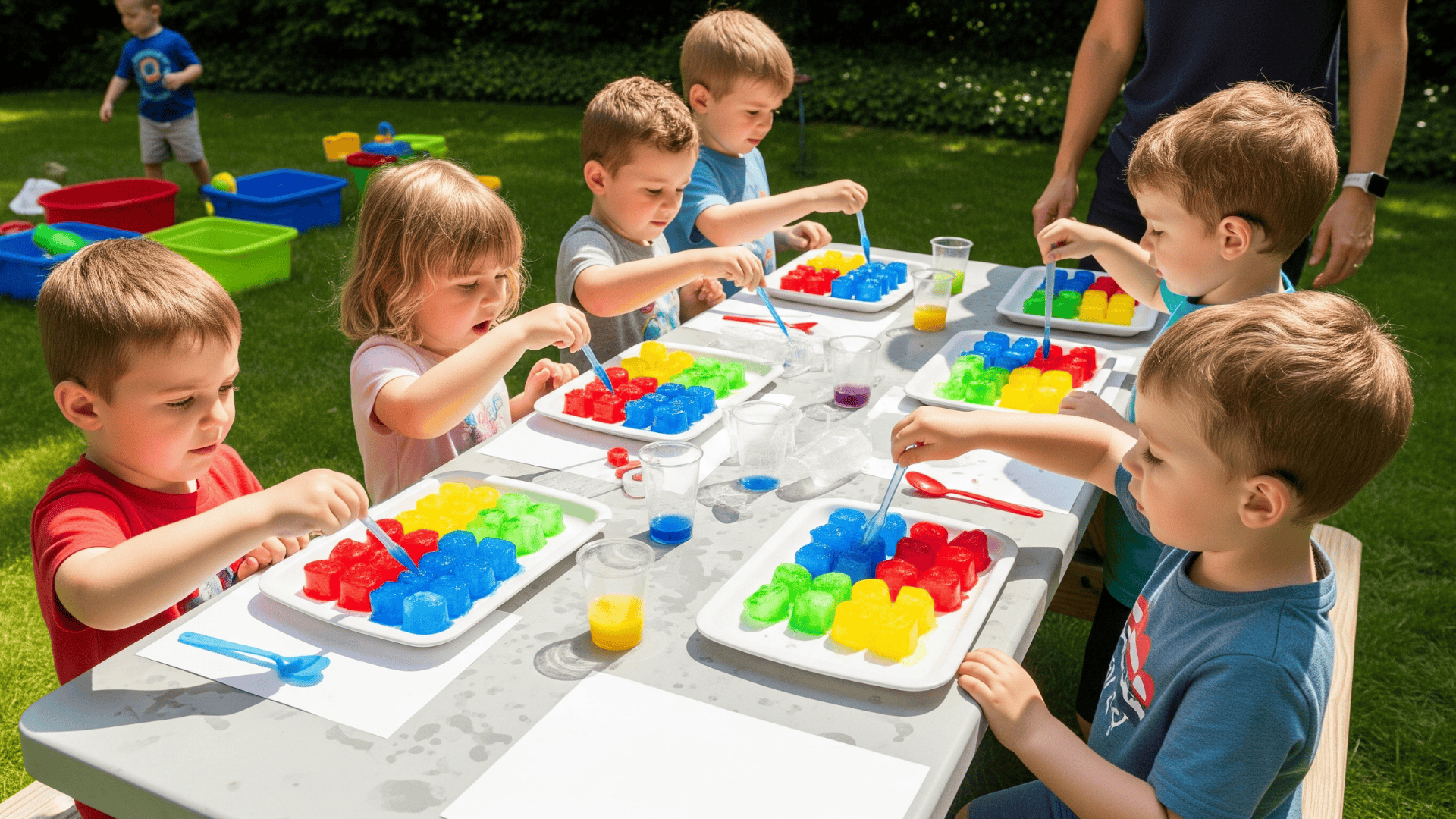
Freeze water with food coloring in ice trays and let children experiment with mixing colors as the cubes melt on paper or in clear containers.
This activity demonstrates color theory, states of matter, and temperature changes through watercolor effects.
Ice cube trays, food coloring, paper, and containers.
Freeze colored water cubes, then let children observe them as they melt and mix.
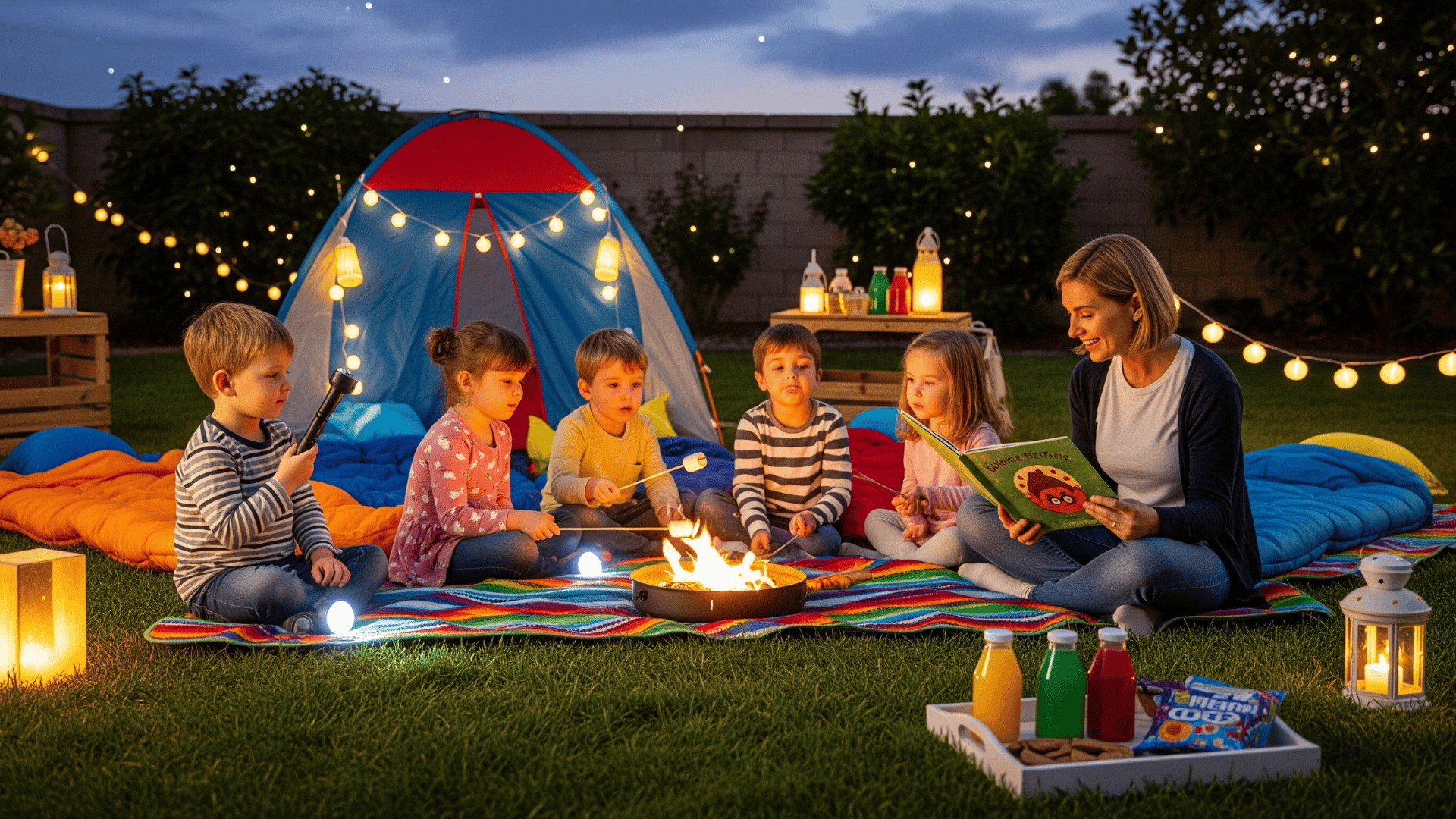
Convert your yard into a wilderness experience by setting up tents or blankets, telling stories, making s’mores, and stargazing all from home.
This camping experience teaches outdoor skills while keeping comfort and safety familiar.
Tent or blankets, flashlights, snacks, and sleeping bags.
Set up shelter, prepare camping snacks, and enjoy outdoor activities together.
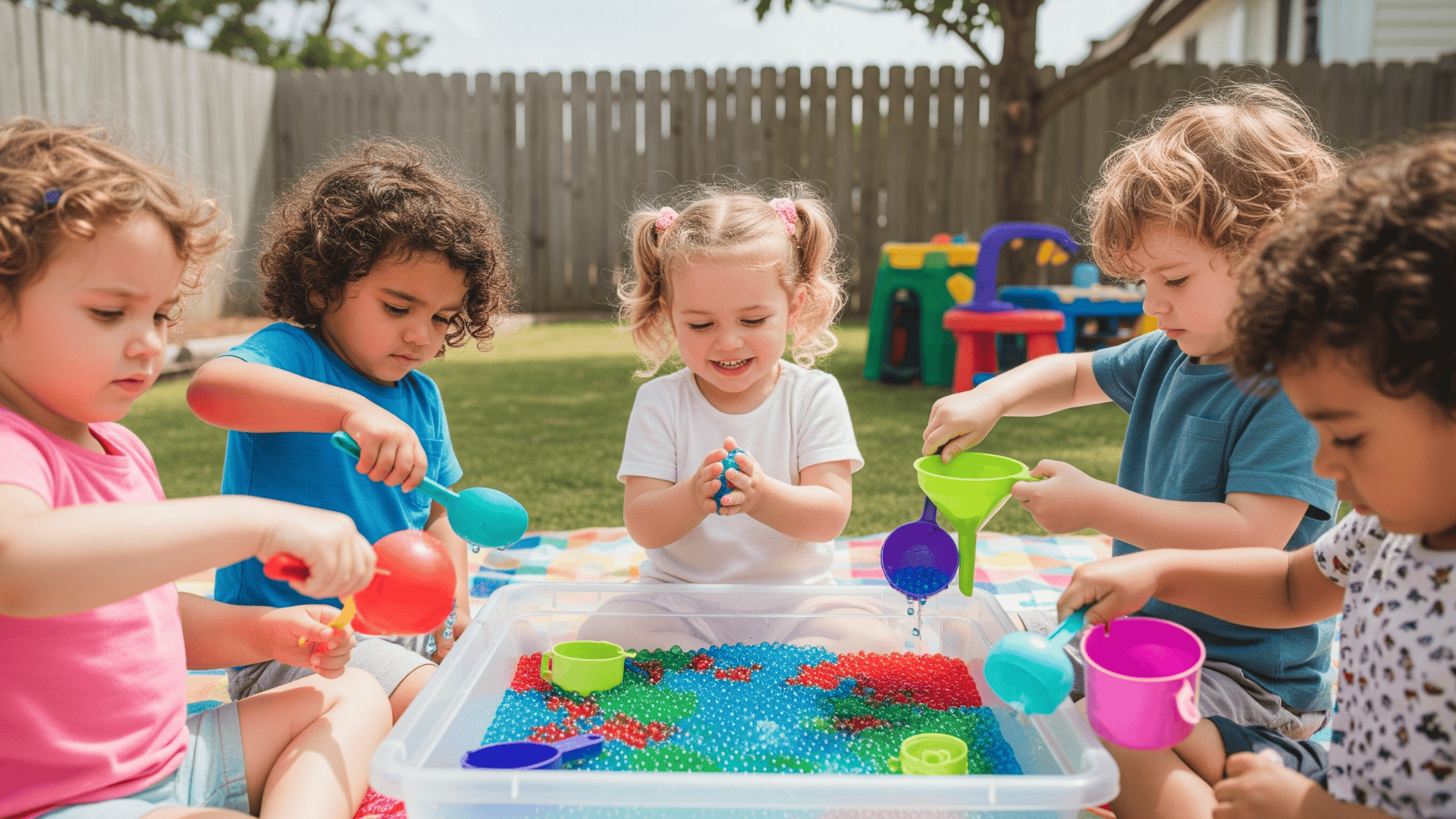
Fill a large container with water beads (polymer crystals) that expand when soaked, providing a tactile experience for scooping, pouring, and exploring.
These colorful, squishy spheres offer a sensory experience and aid in developing fine motor skills through manipulation with tools and containers.
Water beads, large container, water, scoops, cups.
Soak beads according to package directions, then provide tools for exploration.
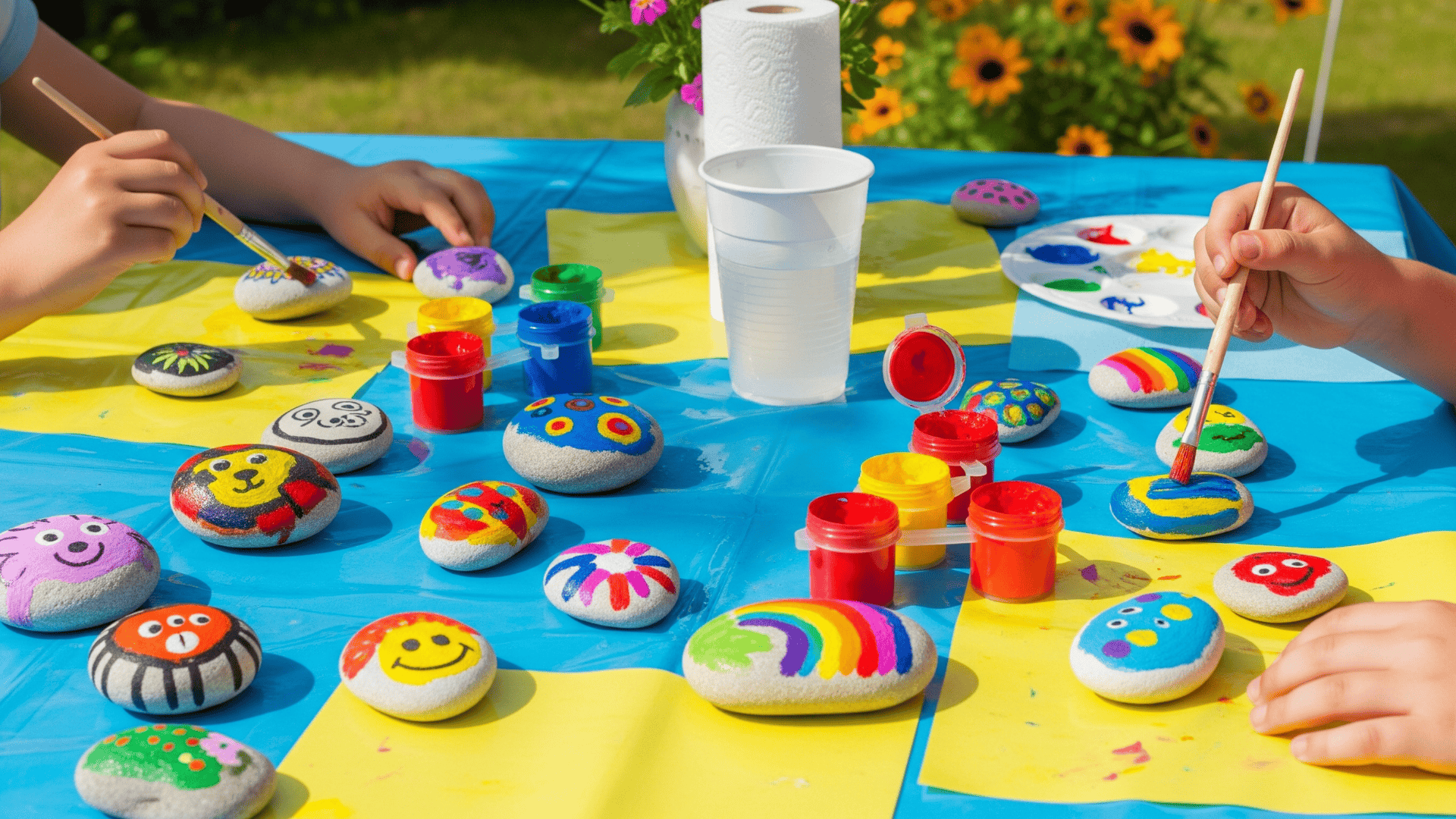
Collect outdoor rocks and turn them into colorful characters, animals, or designs with acrylic paints and brushes.
This artistic activity encourages creativity while developing fine motor skills and color recognition.
Smooth rocks, acrylic paints, brushes, water, paper towels.
Clean rocks thoroughly, apply a base coat if desired, and then paint creative designs.
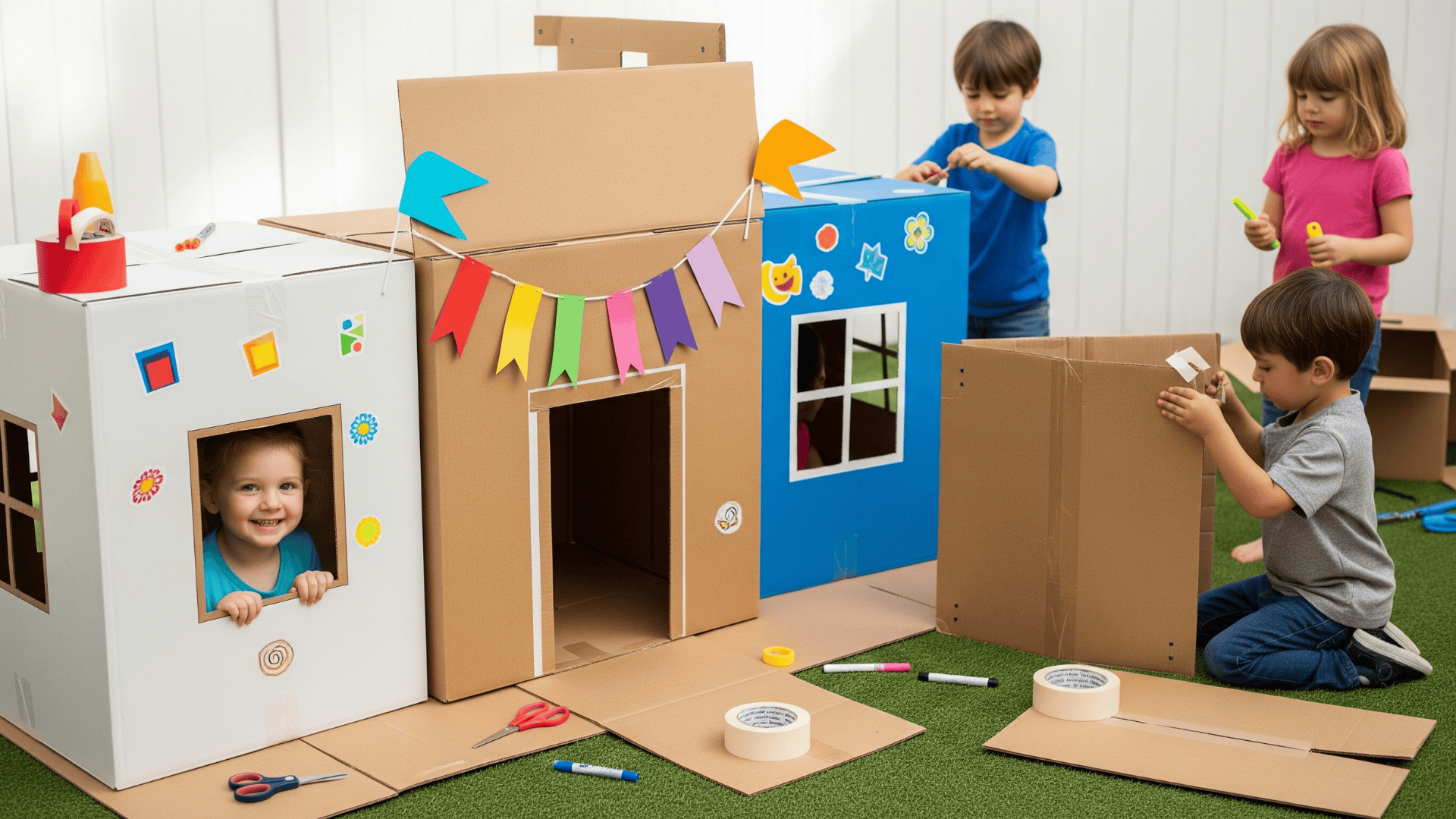
Use large cardboard boxes, tape, and scissors to build fortresses, castles, or hideouts for imaginative play.
This activity boosts spatial reasoning, problem-solving, and creativity, offering a dedicated space for reading, playing, or quiet time.
Large cardboard boxes, tape, scissors, and markers for decorating.
Plan the structure together, then cut openings and secure pieces with tape.
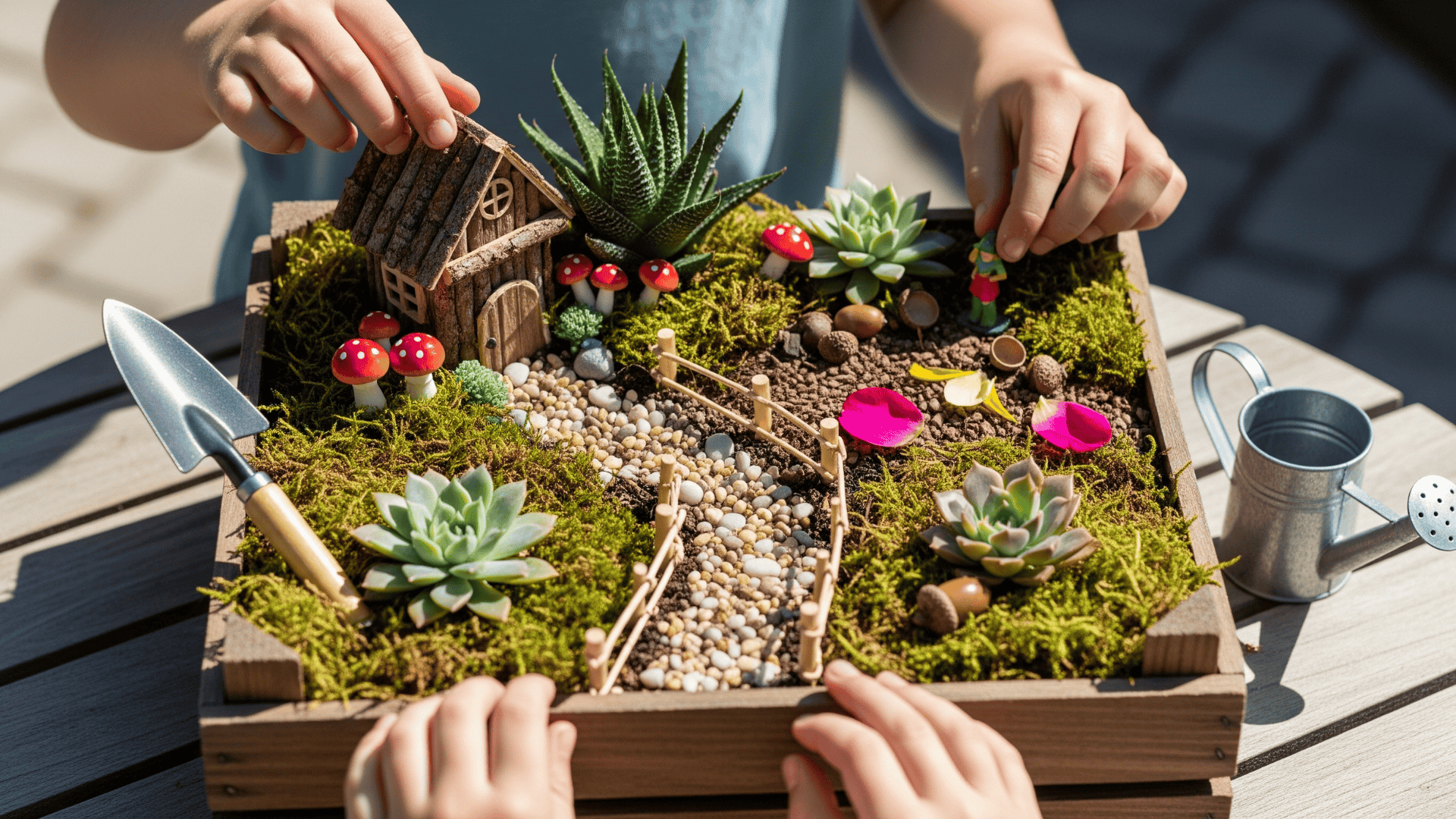
Design miniature landscapes with small plants, tiny decorations, and natural materials to create beautiful outdoor spaces for fairy visitors.
Children develop fine motor skills by arranging small objects and learn about plant growth.
Small plants, miniature decorations, potting soil, and a container or garden space.
Plan the layout, plant flowers, and then arrange small decorative elements throughout the garden.
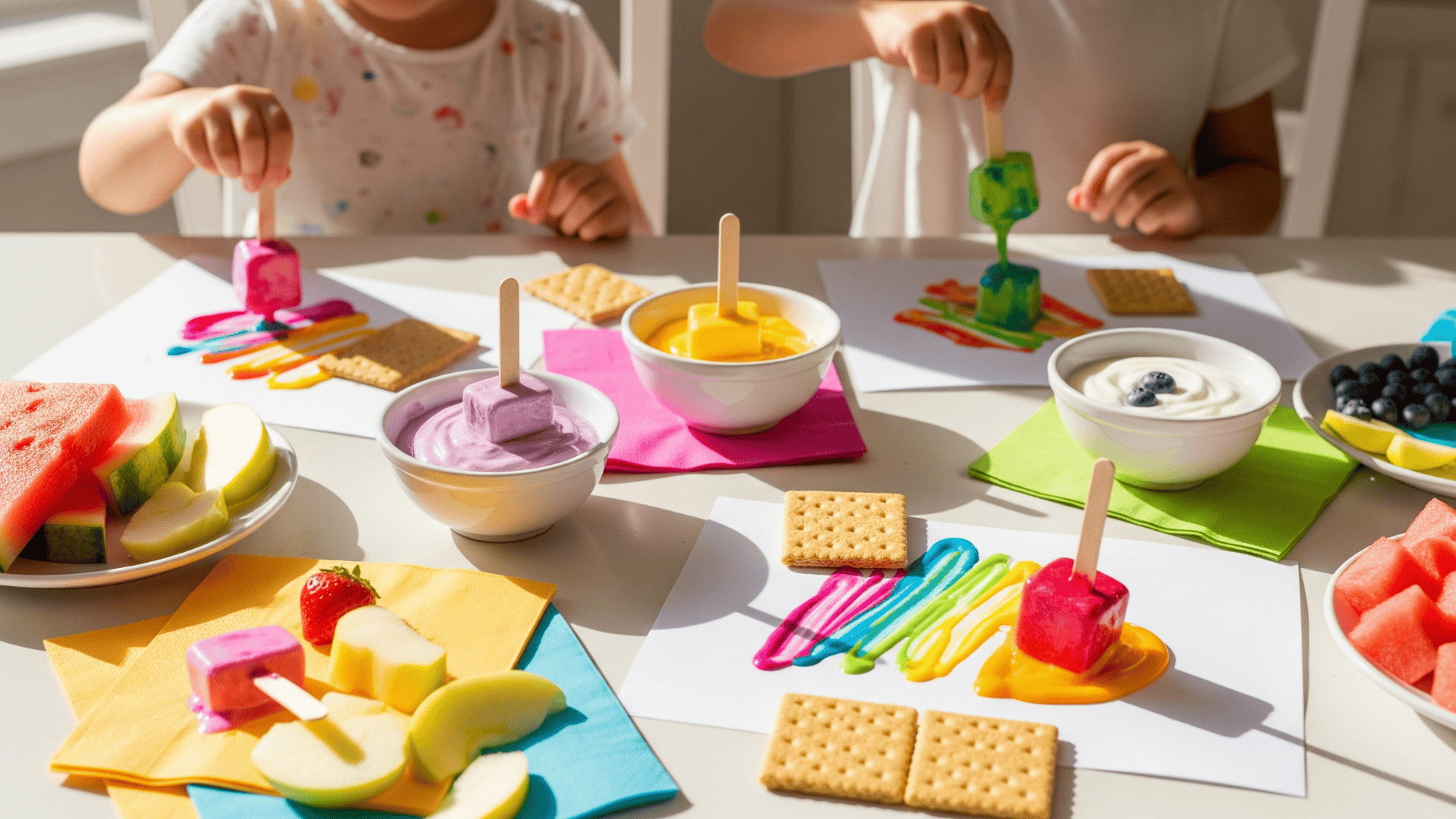
Freeze colored yogurt in ice cube trays with popsicle sticks to make edible paint brushes for art on paper or edible surfaces.
The melting process creates interesting textures and offers opportunities for color mixing.
Plain yogurt, food coloring, ice cube trays, popsicle sticks, paper.
Mix yogurt with coloring, freeze with sticks, then use as edible paintbrushes.
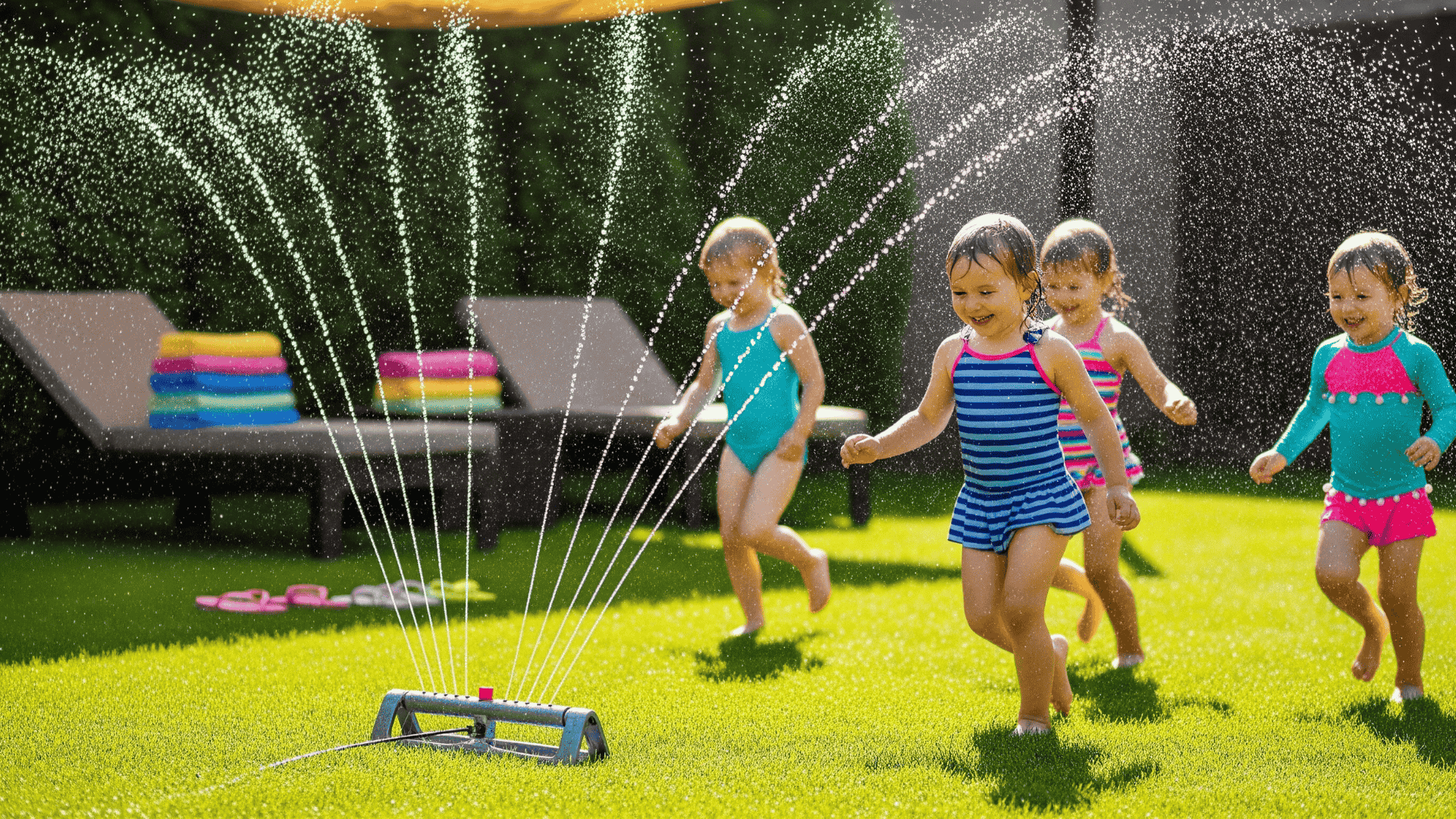
Set up oscillating or stationary sprinklers in the yard for children to run, jump, and dance through the refreshing water spray.
This simple summer activity provides cooling relief while encouraging physical exercise and joyful movement.
Sprinkler system, water source, towels, swimwear.
Position the sprinkler safely, turn on the water, and let children play freely in the spray.
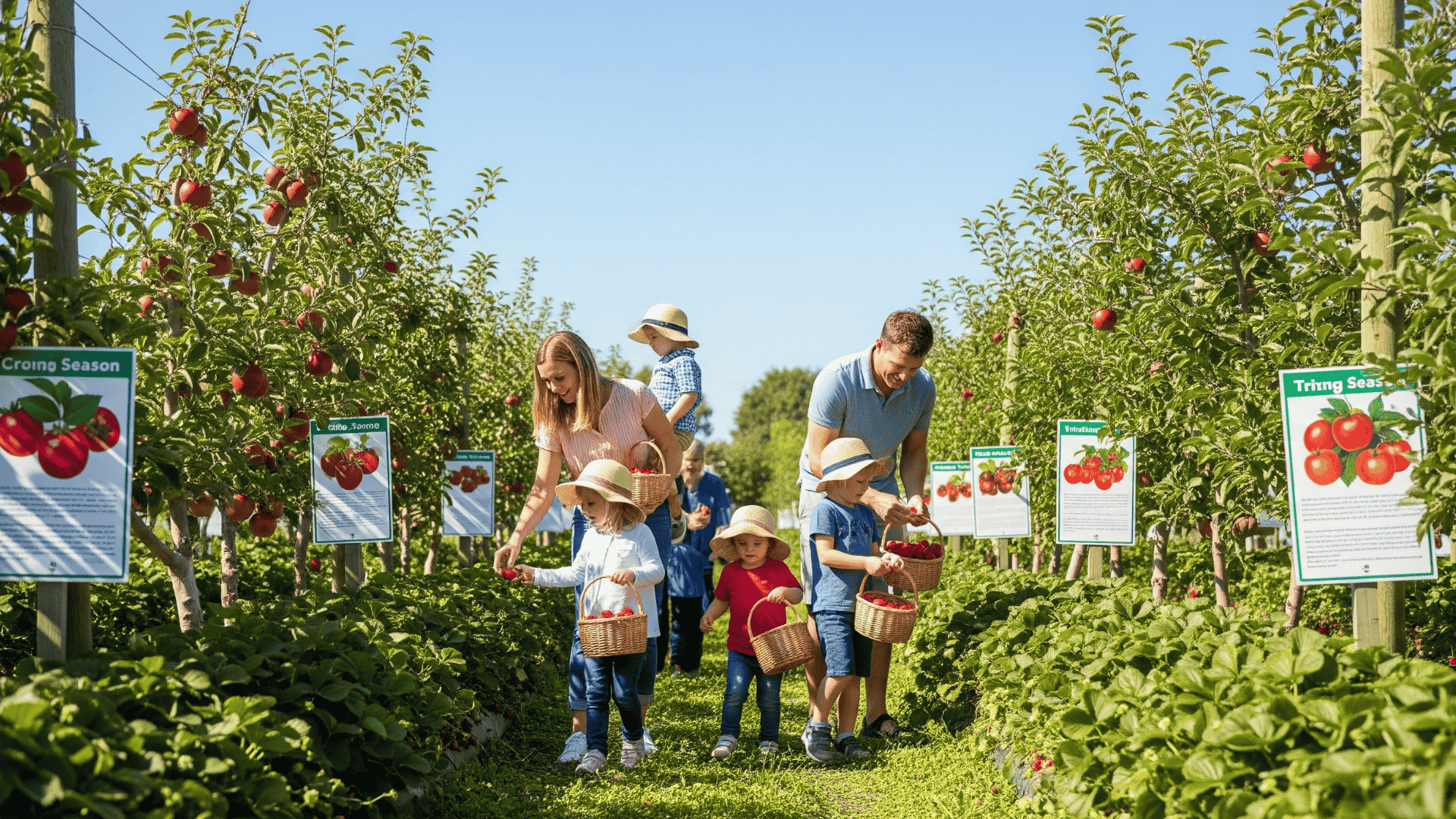
Visit local orchards or berry farms where children can harvest fresh fruits and learn about agriculture and seasonal cycles.
This outing connects children to food sources, teaches farming, and offers healthy snacks.
Baskets or containers, sun protection, comfortable clothing.
Research local farms, call ahead to confirm availability, and supervise safe picking techniques.
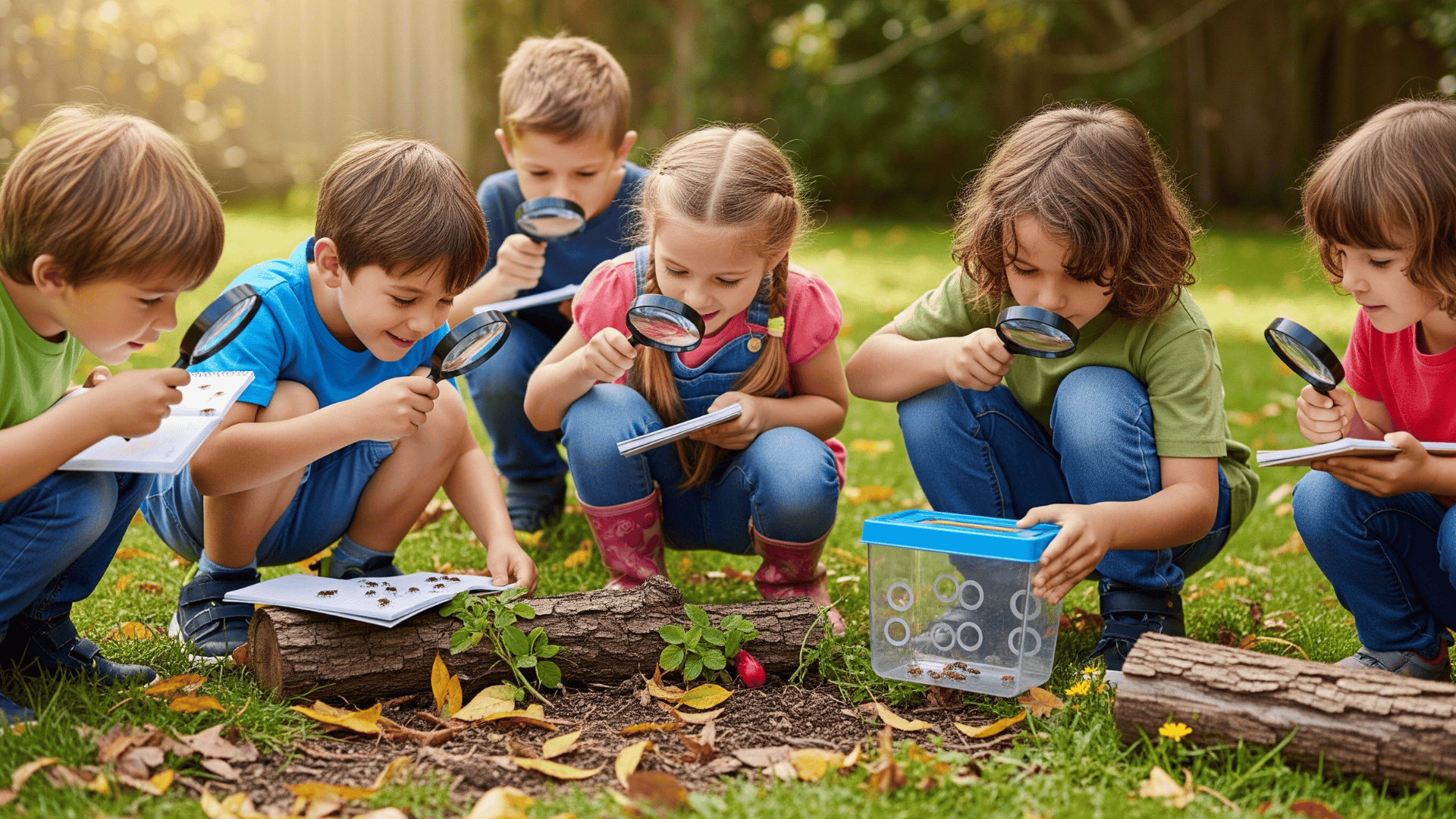
Examine the backyard or park with a magnifying glass to observe insects, learning about species, habitats, and behaviors through careful examination.
This scientific activity develops observation skills, patience, and respect for living creatures..
Magnifying glasses, collection containers, field guides, and a notebook.
Look under logs and leaves, observe carefully, then release insects back to their habitats.
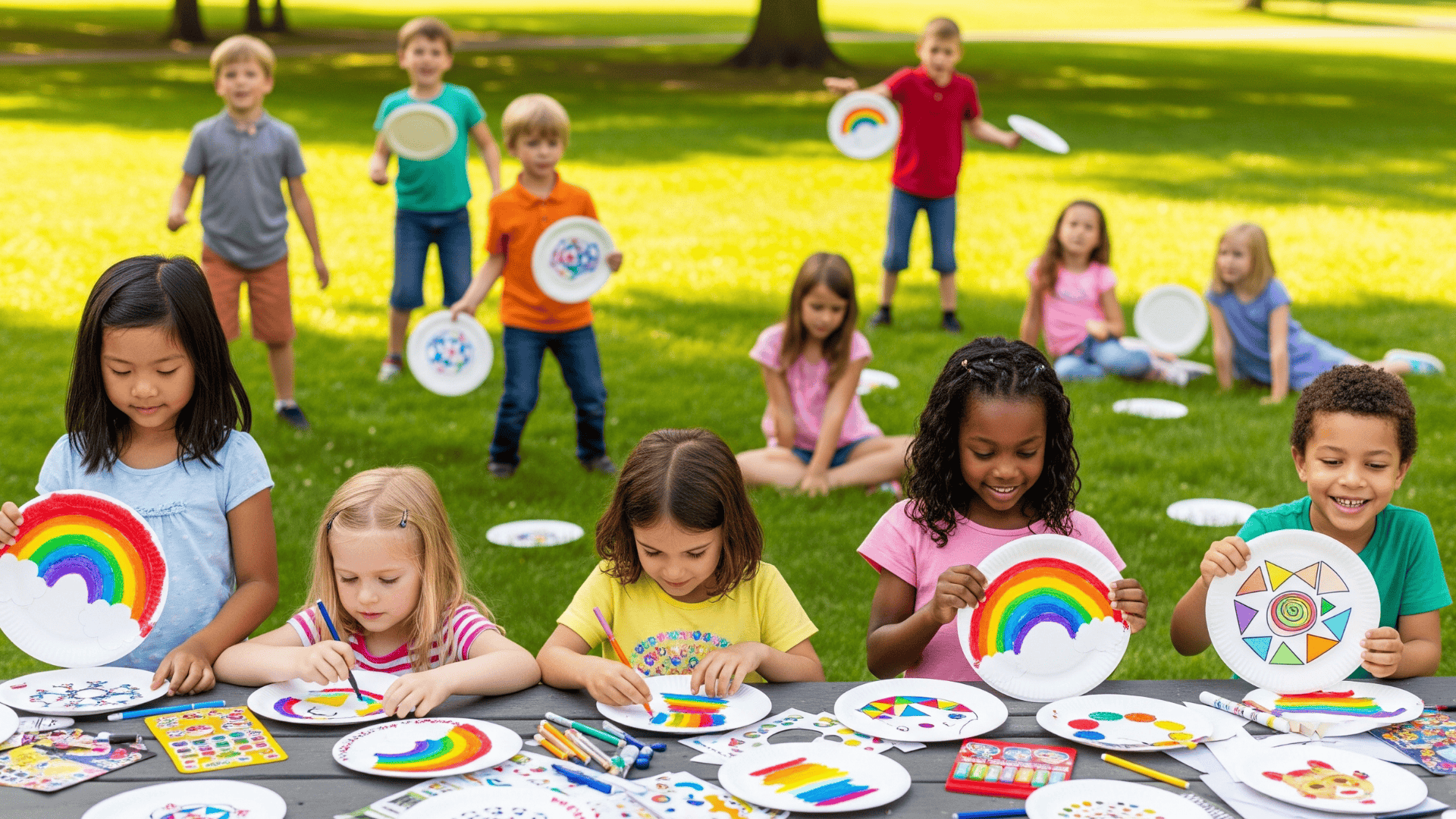
Turn paper plates into colorful flying discs with markers, stickers, and designs, then test their aerodynamics in outdoor games.
Paper plates, markers, stickers, and outdoor space.
Decorate plates with personal designs, then practice throwing techniques for the best flight.
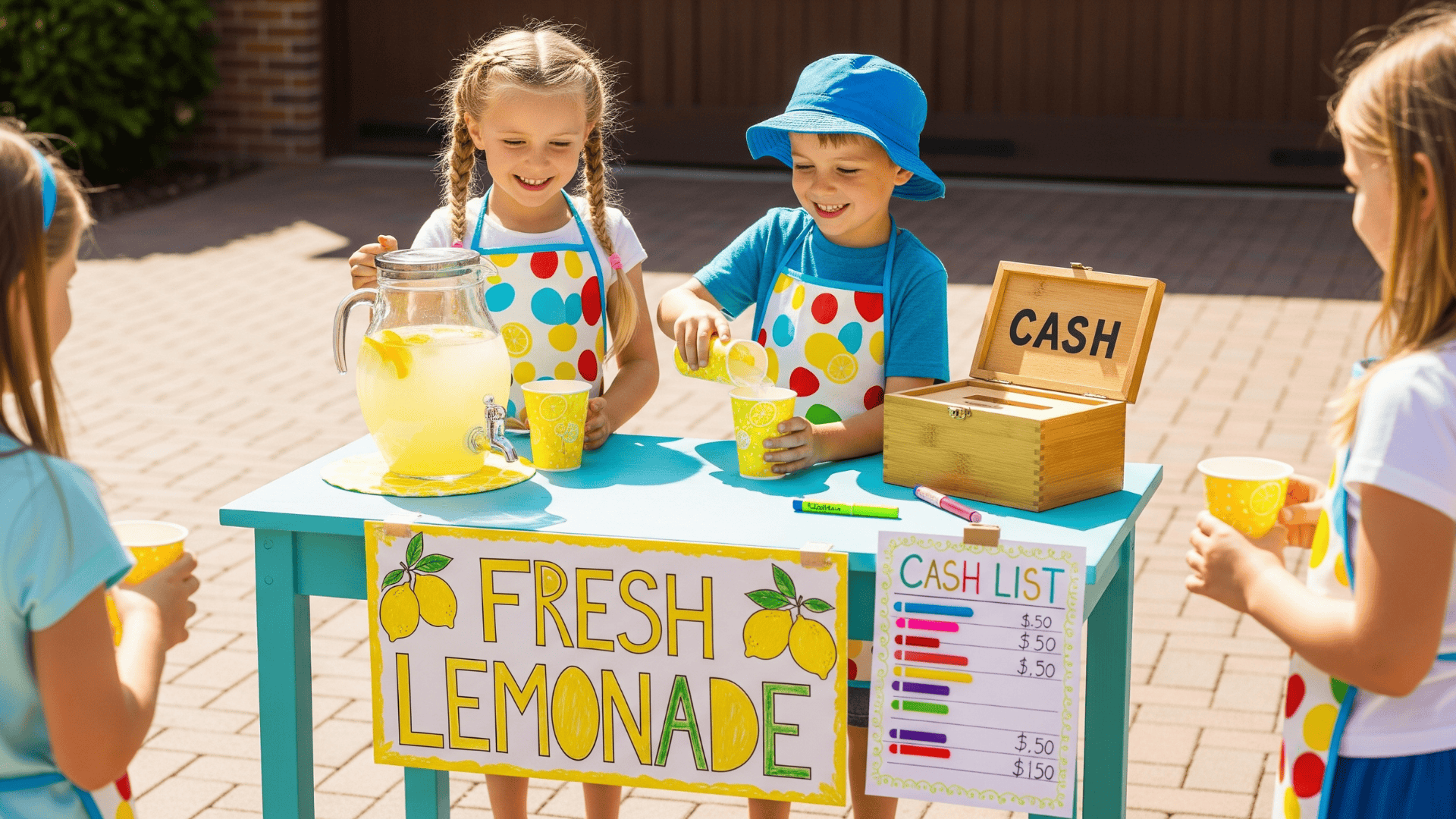
Create a pretend lemonade business to teach children entrepreneurship, money skills, customer service, and math through role-playing.
Children learn responsibility and communication through customer interactions.
Table, cups, lemonade ingredients, play money, and signs.
Prepare lemonade together, set up a stand, and practice greeting customers politely.
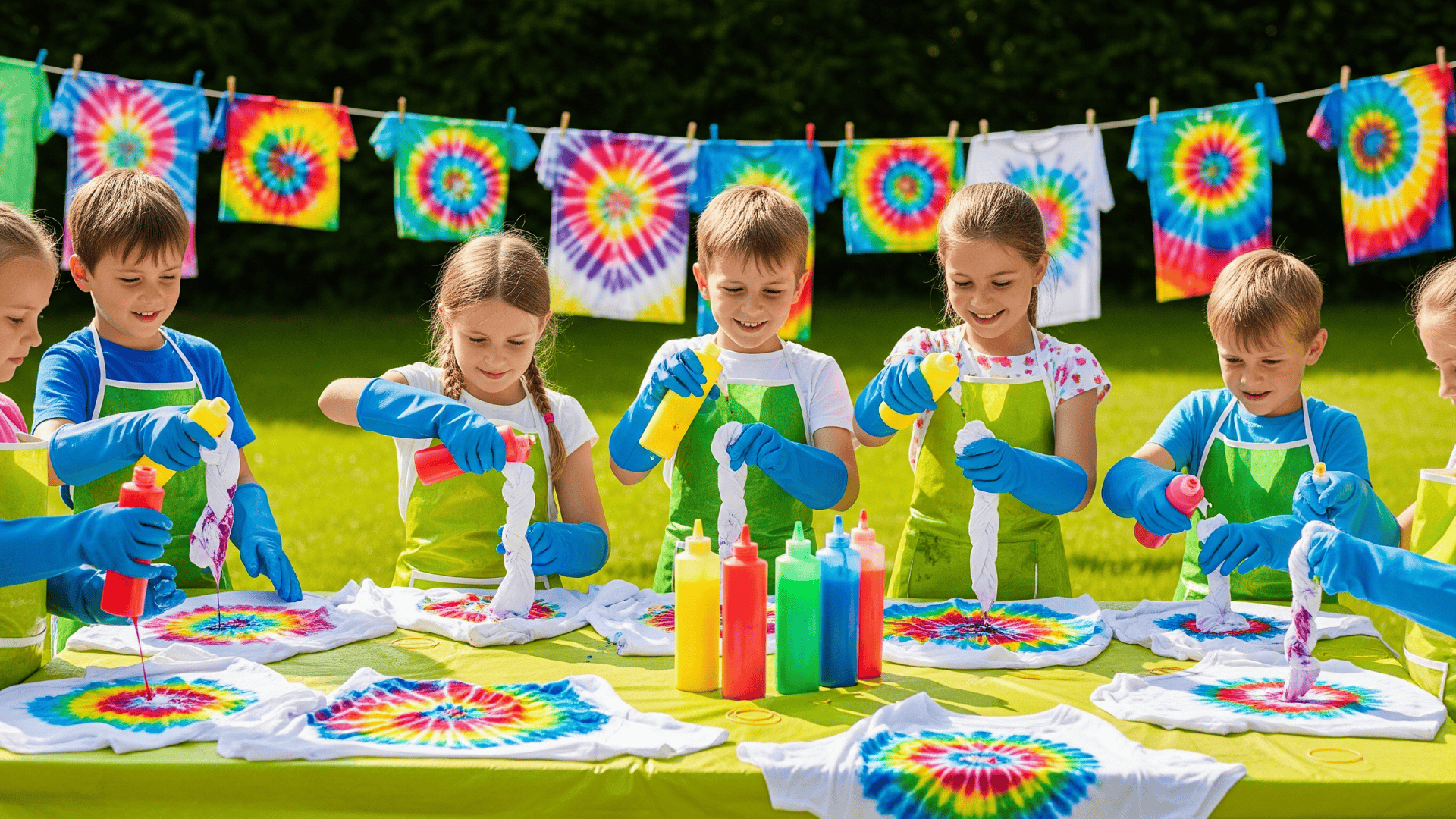
Create colorful, unique clothing by applying fabric dyes in patterns using rubber bands, squirt bottles, and folding on plain white shirts.
This artistic activity teaches color theory and pattern creation while producing wearable art.
White shirts, fabric dye, rubber bands, gloves, squirt bottles.
Fold shirts, secure with bands, apply dye patterns, then wait for processing.
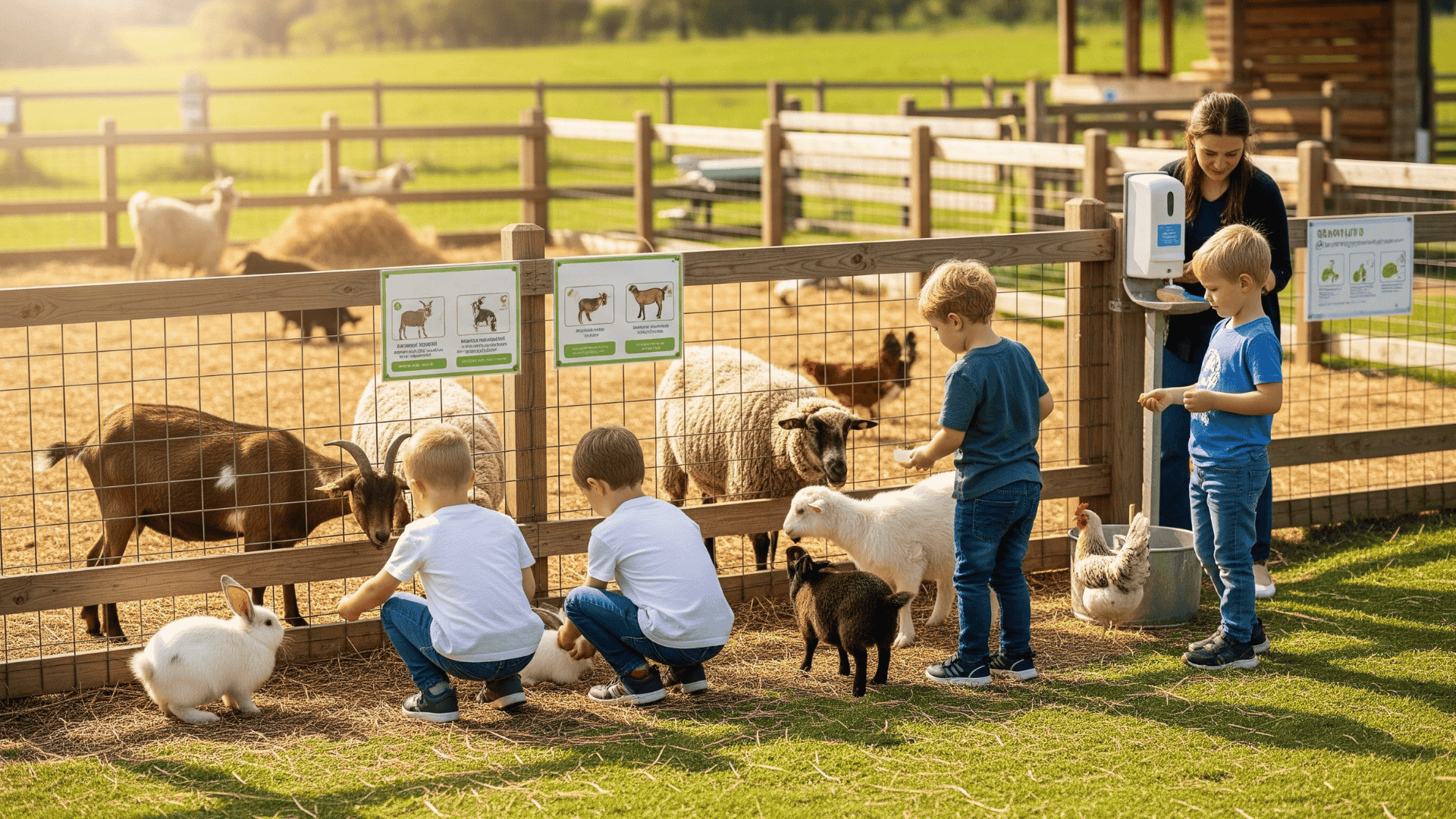
Visit local petting zoos or farms for children to safely interact with gentle animals like goats, sheep, rabbits, and chickens, while learning about their care and behavior.
This educational experience develops empathy, responsibility, and understanding of different species.
Hand sanitizer, comfortable clothing, small fees, and a camera.
Research local facilities, follow all safety rules, and supervise animal interactions carefully.
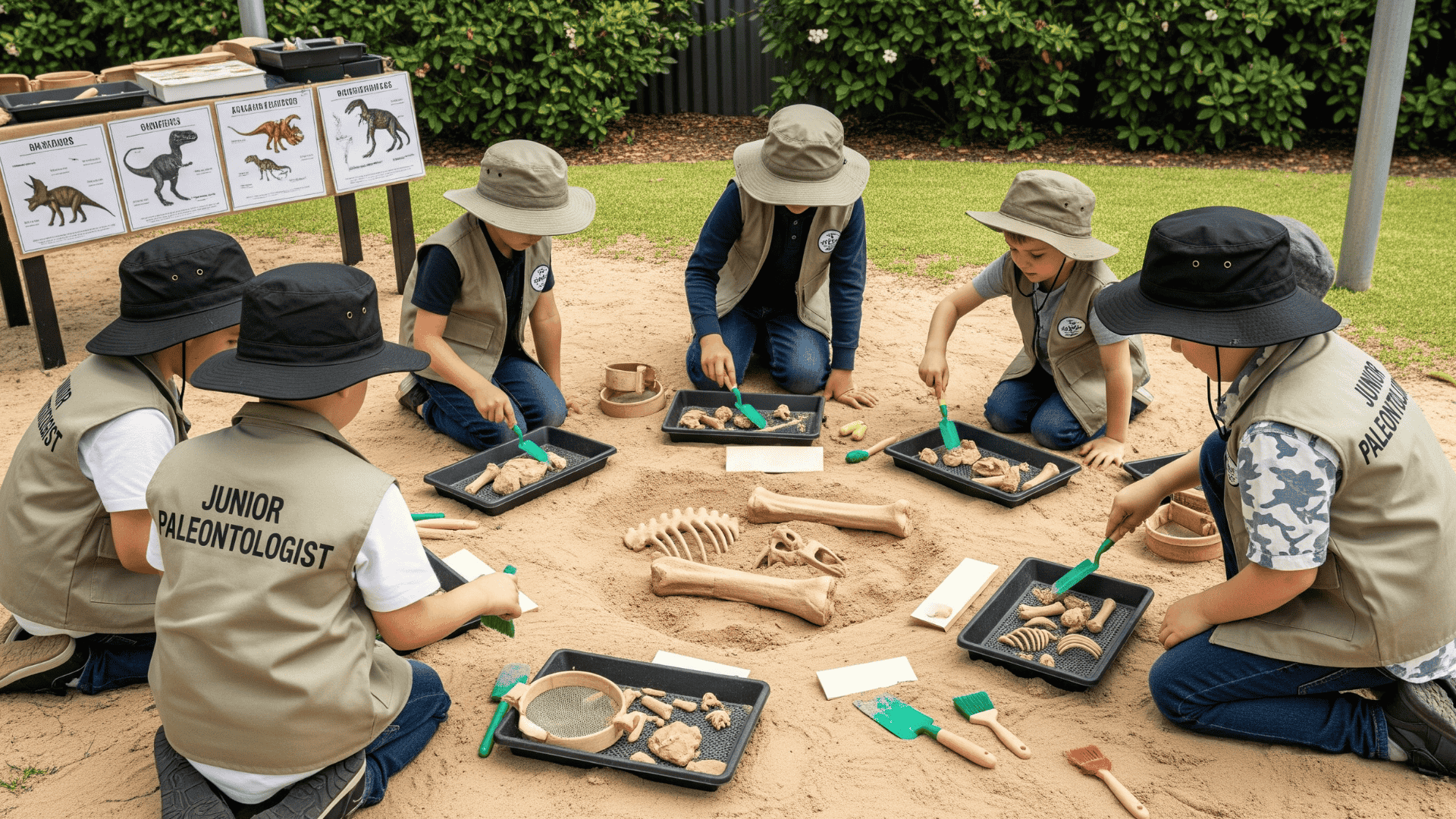
Hide plastic dinosaur skeletons or bone-shaped items in sandbox sand for children to excavate with brushes and tools, mimicking real paleontology findings.
Children learn about prehistoric life through hands-on archaeological roleplay.
Plastic bones, sandbox sand, brushes, and small tools.
Bury items in sand beforehand, provide excavation tools, then guide careful digging techniques.
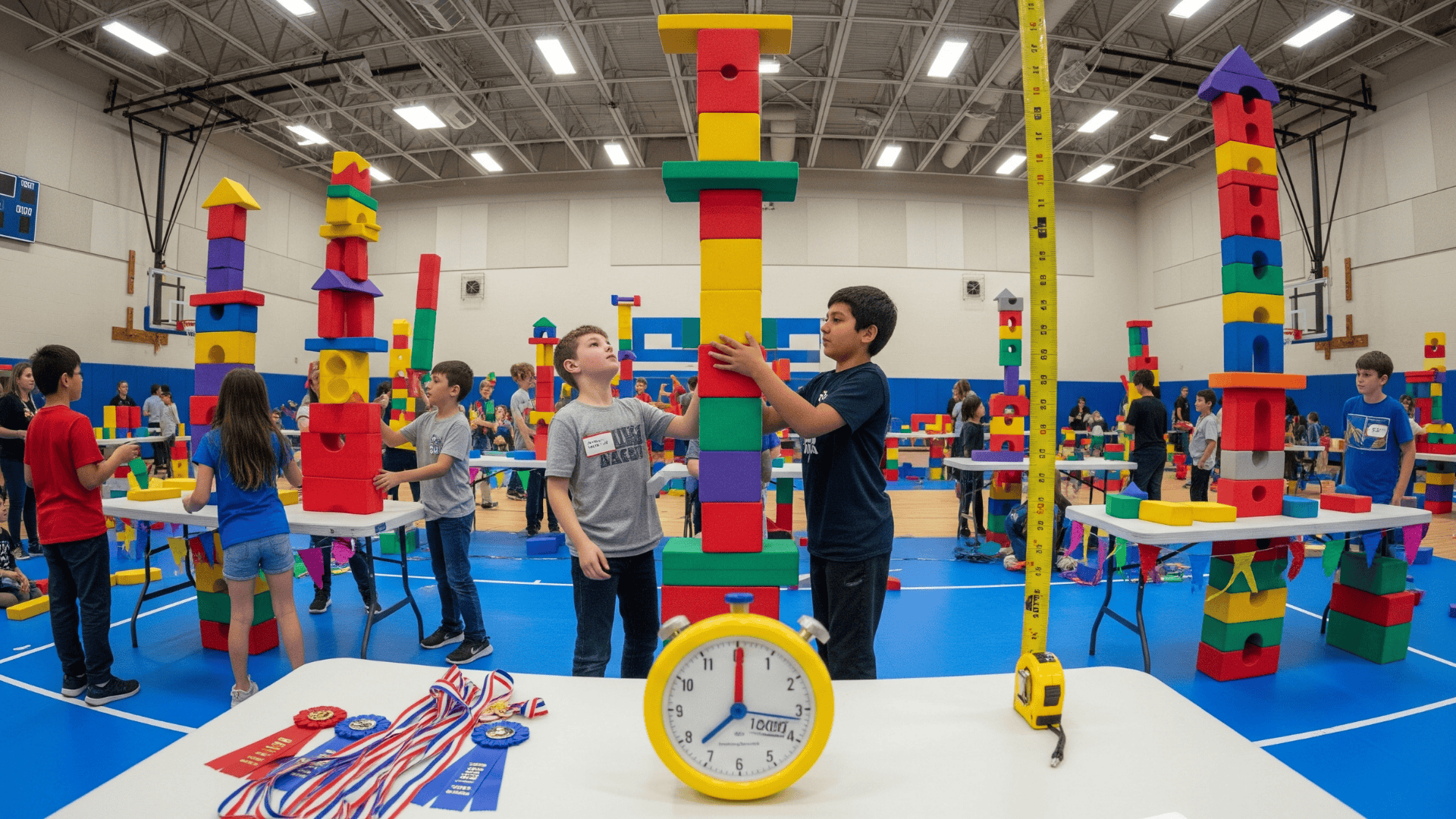
Challenge children to build the tallest, most creative structures with foam blocks, fostering engineering skills and friendly competition.
Children learn from trial and error while exercising creativity and persistence in building challenges.
Large foam blocks, measuring tape, timer, and prizes.
Set building challenges, provide time limits, then measure and celebrate all creative constructions.
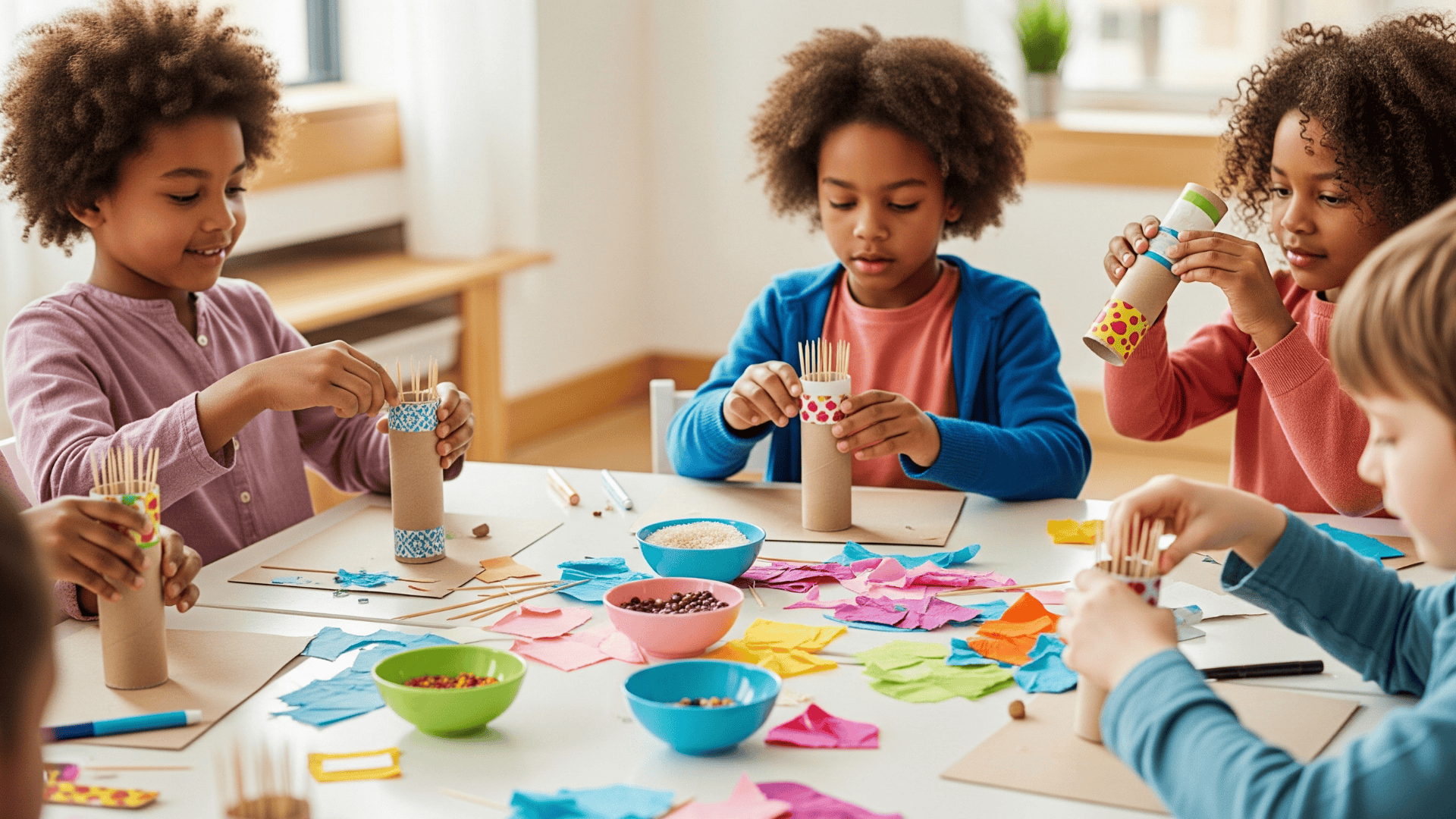
Create musical instruments by filling cardboard tubes with rice or beads, sealing ends, and decorating the exterior for sound-making activities.
Children learn cause-and-effect relationships through sound creation.
Cardboard tubes, rice, tape, decorating supplies, and toothpicks.
Insert toothpicks along the tube, add rice, seal ends, then decorate the exterior creatively.
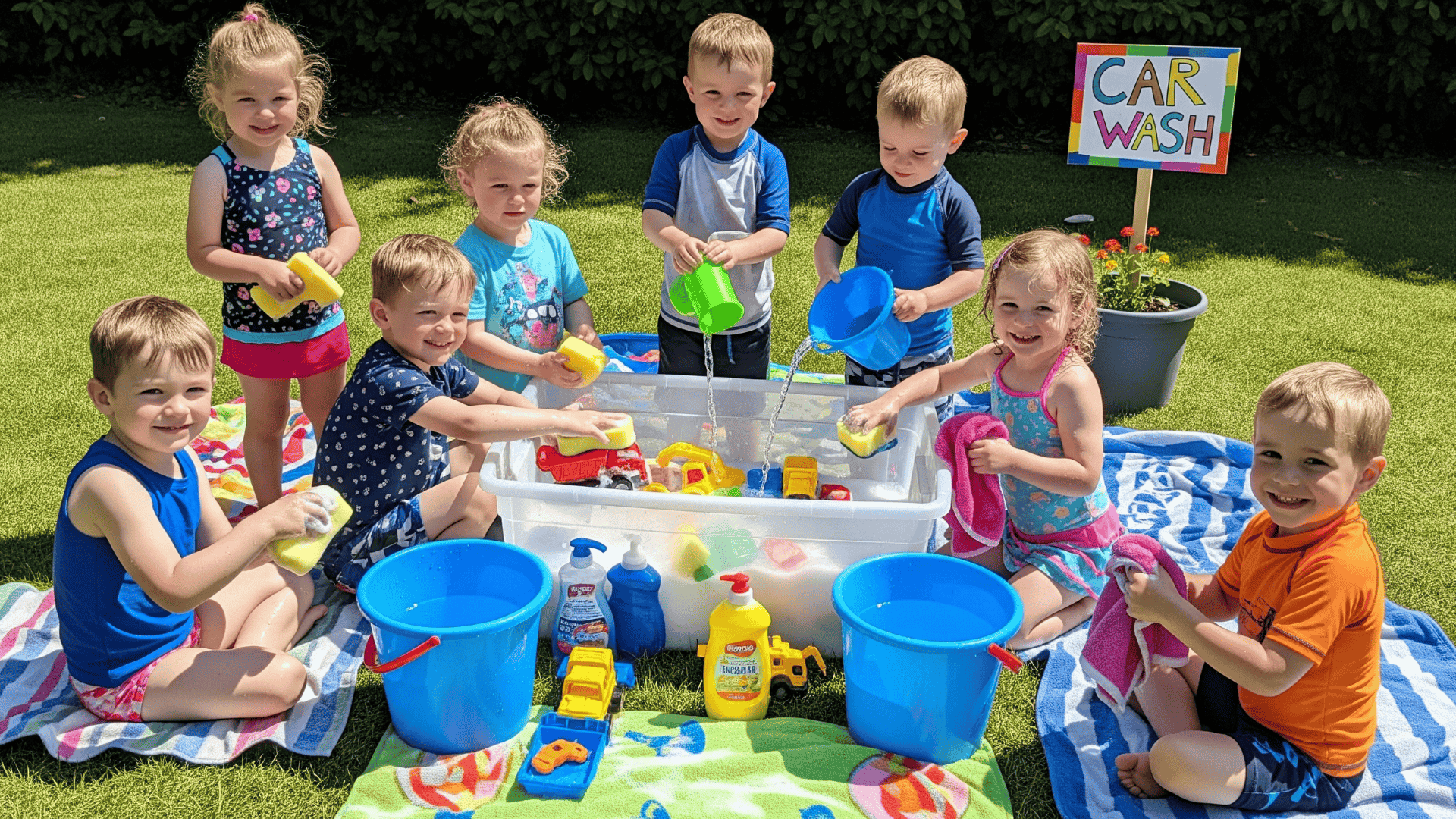
Set up shallow tables or bins with soap, sponges, and towels for children to wash toy cars and vehicles during pretend play.
This sensory activity develops fine motor skills while encouraging imaginative play and responsibility.
Water table, toy vehicles, soap, sponges, and towels.
Fill the table with soapy water, provide washing tools, and encourage thorough cleaning of the vehicle.
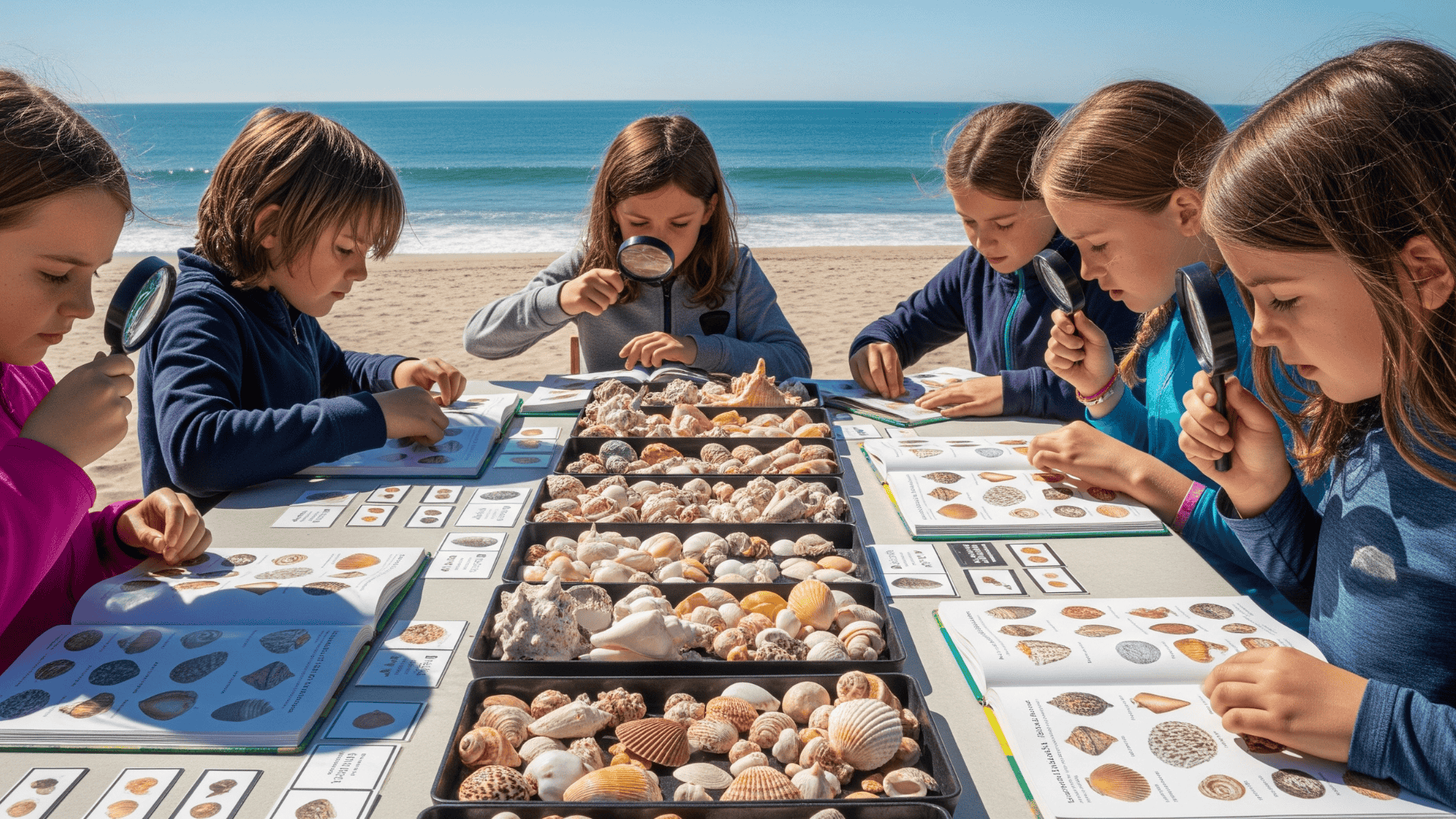
Collect seashells during beach visits or buy different shells for sorting and classification games that enhance observation and categorization skills.
This educational activity teaches about marine life, natural patterns, and scientific classification methods.
Variety of seashells, sorting trays, magnifying glass, reference books.
Examine shells closely, sort by characteristics like size, color, or pattern.
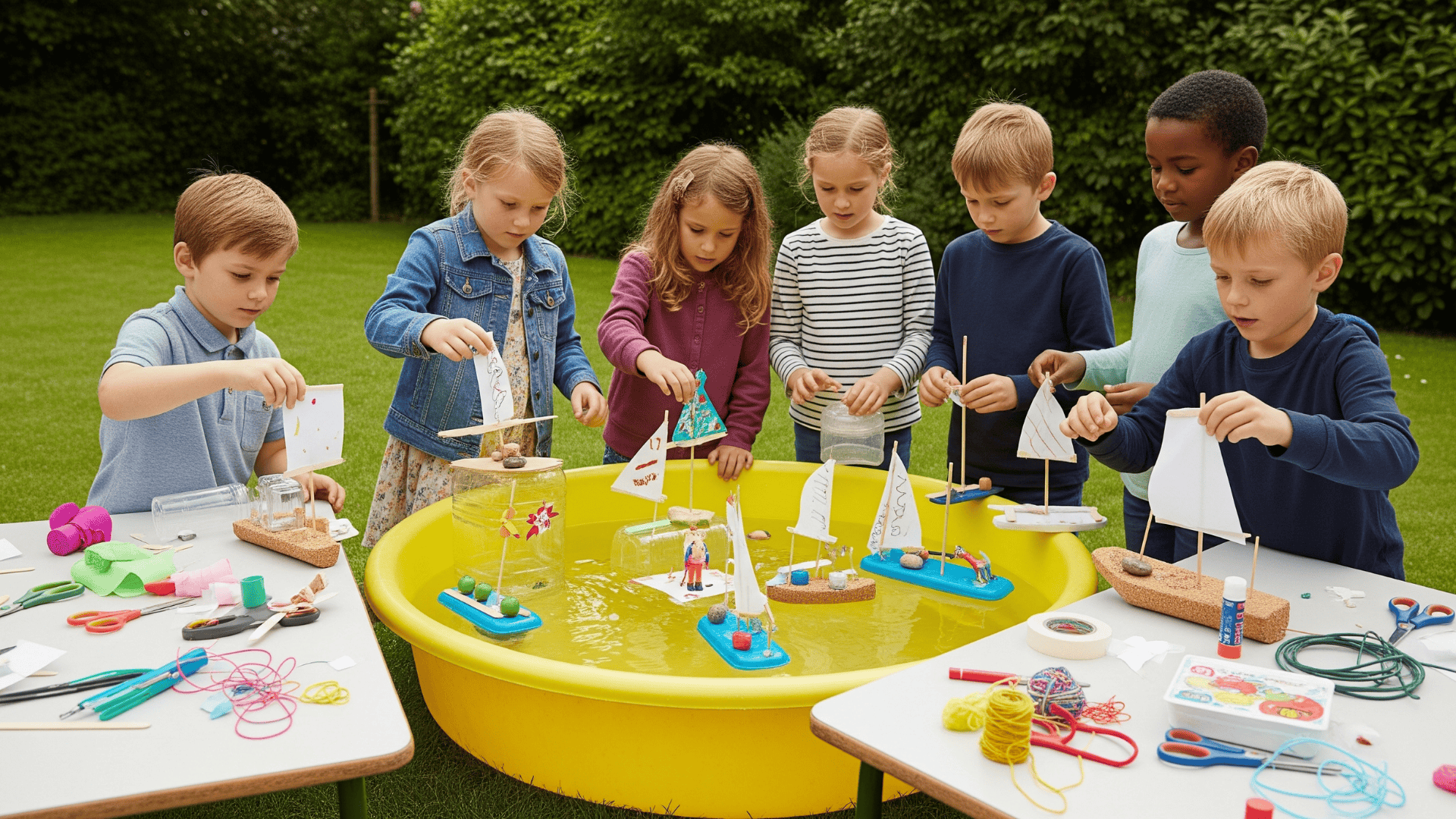
Build simple watercraft from recyclable materials like plastic containers, corks, and fabric sails. Test their buoyancy and stability in water basins.
Children learn through experimentation and modification of their floating creations.
Recyclable containers, craft materials, water basin, and small objects for cargo.
Design and build boats, then test modifications to improve floating and stability.
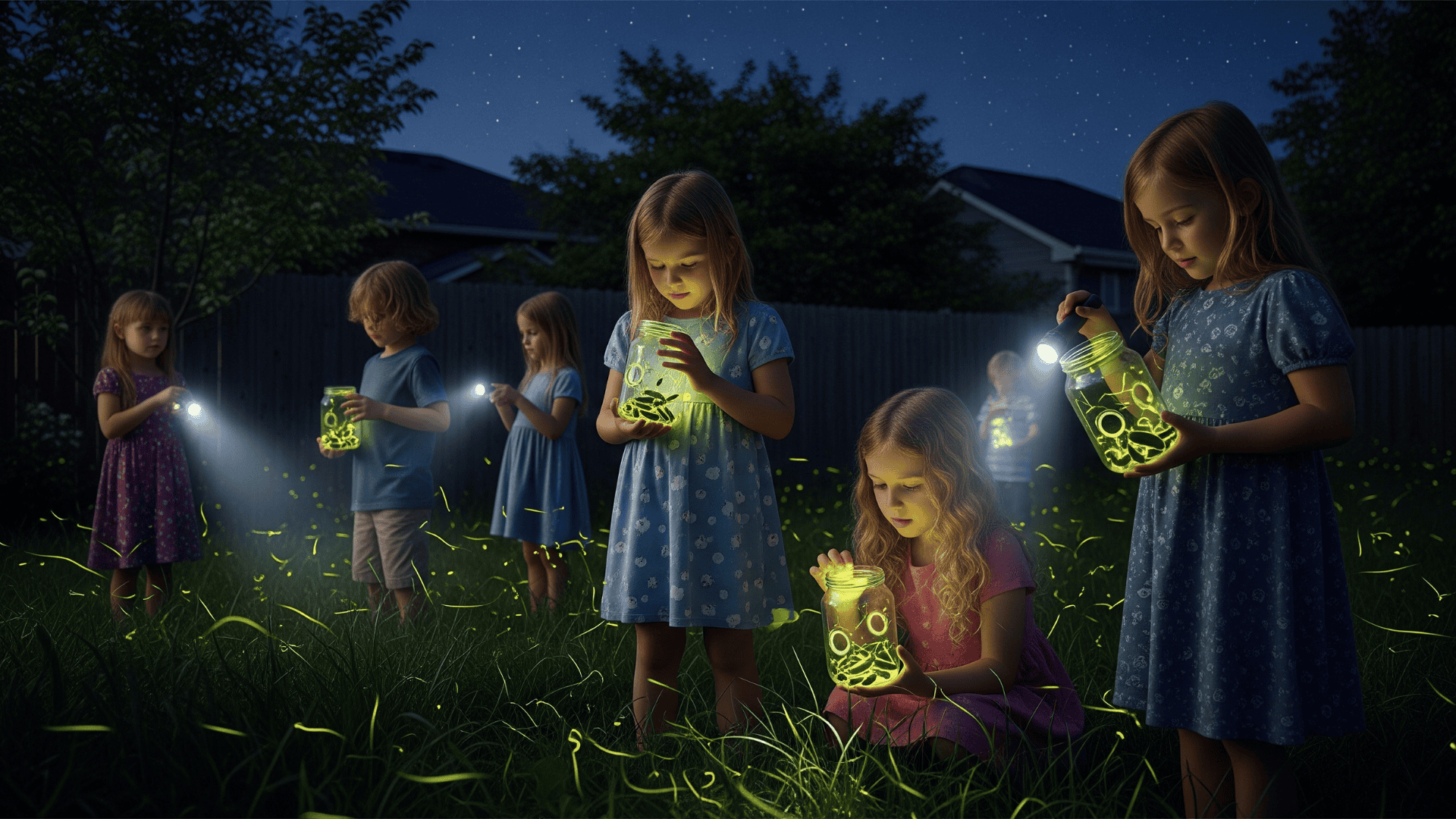
During summer evenings, gently capture fireflies in containers with air holes to observe their bioluminescence before releasing them safely.
This activity teaches about nocturnal insects, natural light production, and respecting living creatures.
Clear containers with lids, a flashlight, and gentle hands.
Catch fireflies carefully in containers, observe them briefly, and then release them immediately back to their habitat.
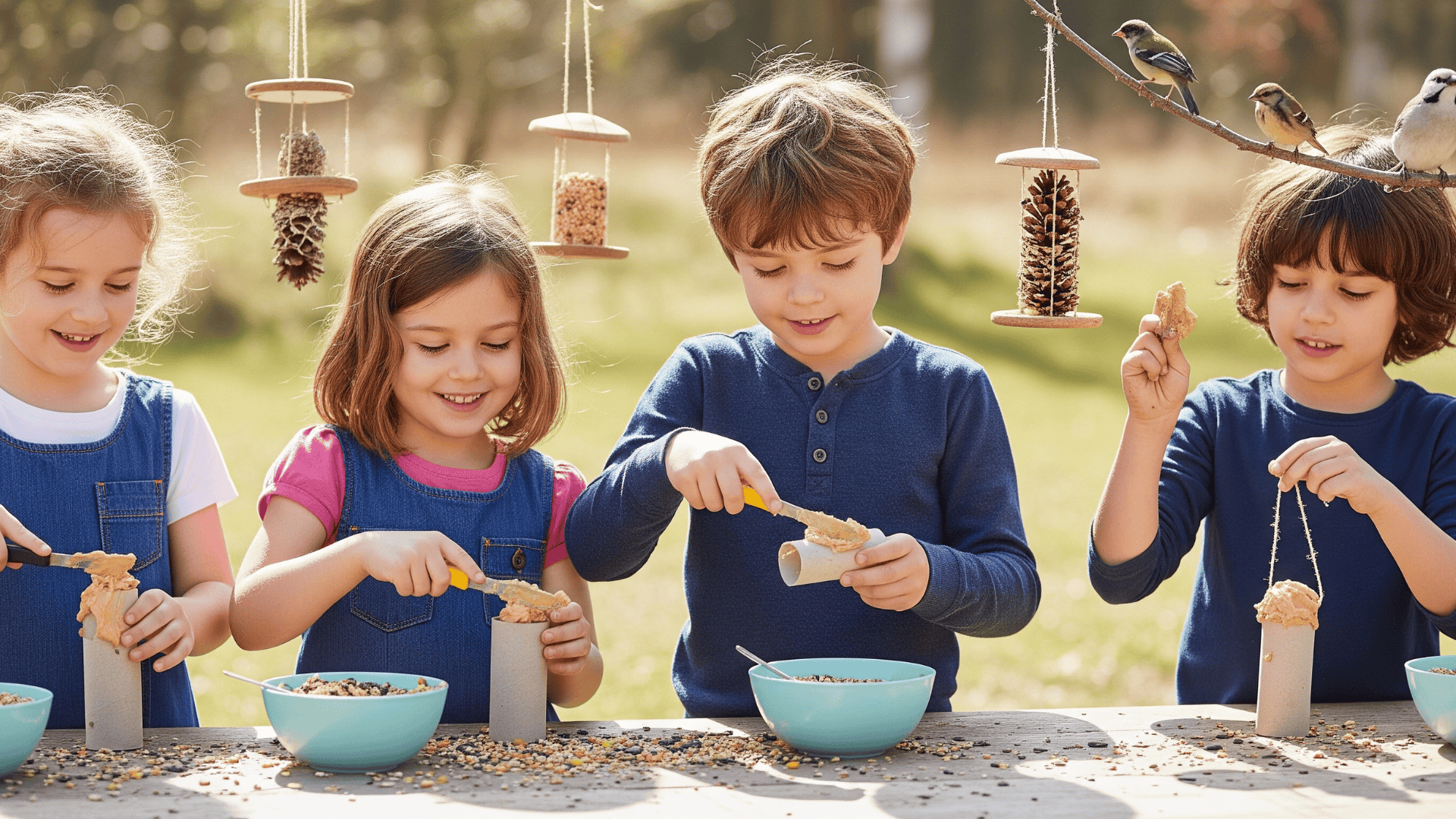
Spread peanut butter on pinecones, toilet paper rolls, or wood, then roll in birdseed to make bird feeding stations.
This craft teaches bird diets, seasonal feeding, and conservation, offering ongoing observation.
Pinecones, peanut butter, birdseed, string, spreading tools.
Cover surfaces with peanut butter, roll in seeds, and hang in safe locations.
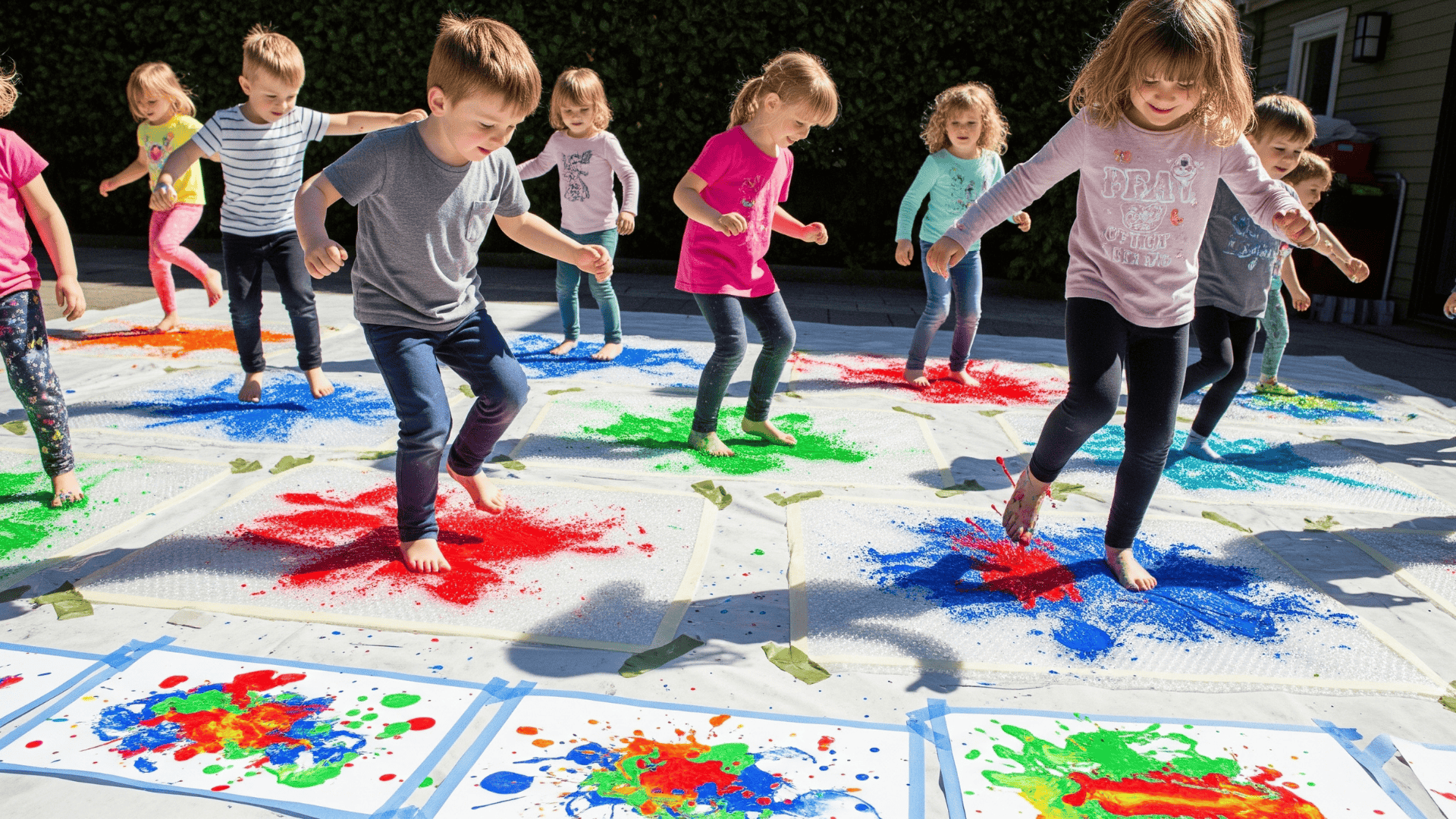
Tape large bubble wrap sheets to paper, add paint drops, then have children stomp, jump, and dance on it to make textured art.
This energetic activity combines physical movement with artistic expression while producing interesting visual effects.
Bubble wrap, paper, washable paint, tape.
Secure bubble wrap over paper, add paint drops, then encourage creative stomping movements.
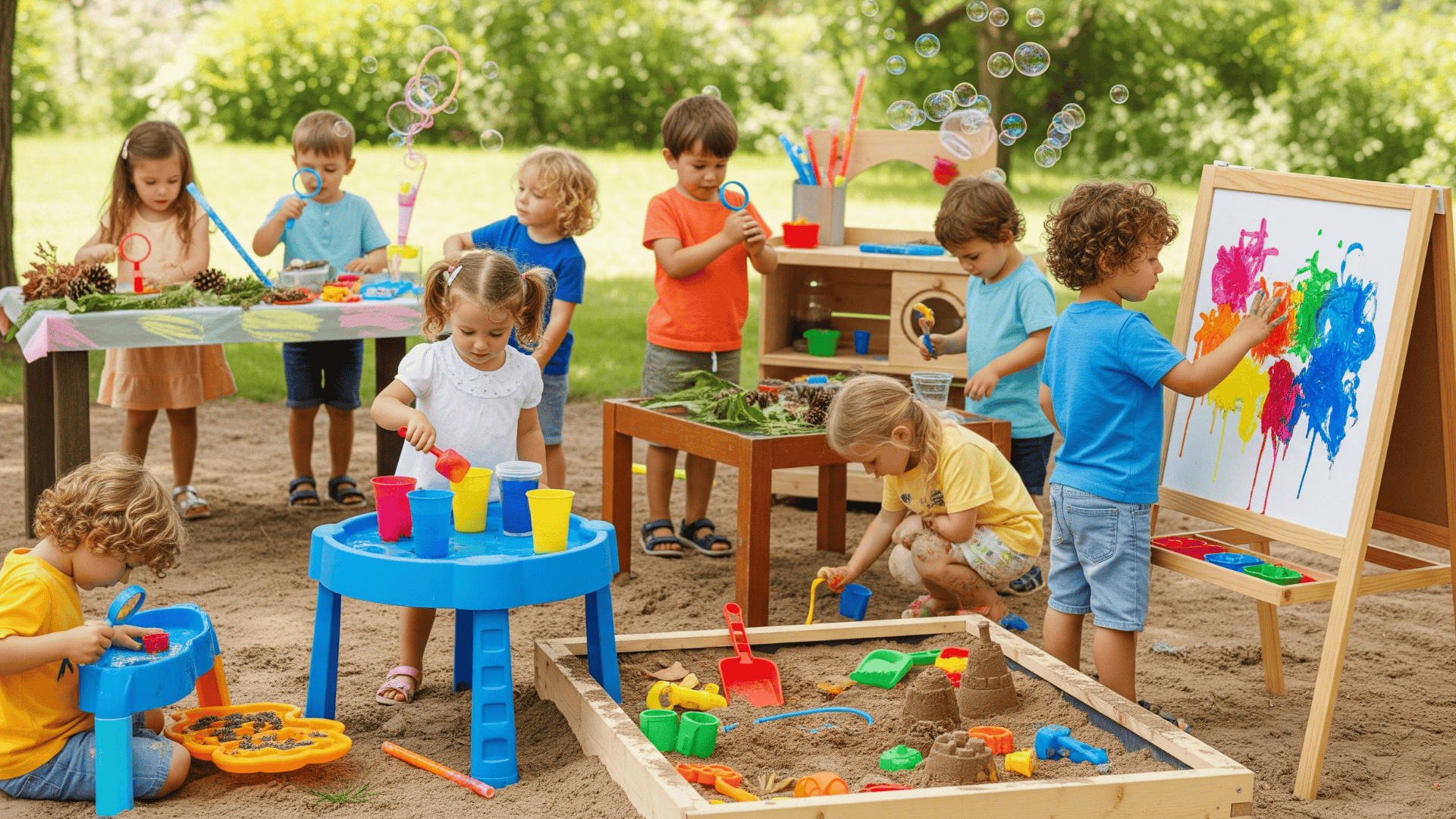
Preschoolers thrive on simple, sensory-rich summer activities suited to their developmental needs and shorter attention spans.
These activities foster fine motor skills, color recognition, and early science thinking while engaging children outdoors.
Cut pool noodles into rings and set up target posts for classic ring toss games that develop hand-eye coordination and aiming skills.
Pool noodles, scissors, and target posts or cones.
Cut noodles into rings, set up targets at varying distances, then practice tossing.
Apply shaving cream to vertical surfaces like shower walls or fences for tactile exploration, drawing, and sensory play.
Children develop fine motor skills and sensory processing through therapeutic touch experiences.
Shaving cream, washable surface, towels, water.
Apply cream to the wall surface, encourage finger drawing and sensory exploration freely.
Create colorful wind indicators using fabric strips, plastic bags, or streamers attached to hoops or containers to study wind direction and movement patterns.
Children learn to recognize environmental cues and understand how wind influences their daily activities.
Fabric strips, hoops, string, decorating supplies.
Attach colorful strips to the hoop base, add a hanging string, then observe wind effects.
Play upbeat music and encourage children to dance freely until the music stops, then freeze in creative positions until the music resumes.
Children learn to follow directions and express themselves through dance and movement.
Music player, open space, upbeat songs.
Play music, encourage creative dancing, pause randomly for a freeze, then resume dancing.
Take children to public water play areas with fountains, sprays, and interactive features for safe summer cooling and play.
The experience teaches water safety and appreciation for community resources.
Swimwear, towels, sunscreen, water bottles.
Research local splash pads, apply sunscreen regularly, and supervise water play activities.
Start gardening by planting large sunflower seeds in pots or beds, teaching children about plant growth, responsibility, and patience.
Children learn about plant needs and develop nurturing skills through consistent care.
Sunflower seeds, soil, pots, water, sunny location.
Plant seeds according to package directions, water regularly, and track growth progress.
Make translucent window decorations using contact paper, tissue paper, and natural materials to capture and display colorful light patterns.
This art activity teaches about light, color mixing, and transparency while creating beautiful room decorations.
Contact paper, tissue paper, natural materials, scissors.
Arrange materials between the contact paper layers, seal the edges, and then hang in a sunny window.
Pack homemade or simple foods in baskets or bags for outdoor dining experiences in parks, backyards, or natural settings.
Children learn about preparation, cleanup, and enjoying meals in different environments.
Food, blankets, utensils, drinks, and cleanup supplies.
Plan menu together, pack carefully, find a suitable location, and enjoy outdoor dining.
Construct spinning toys using colorful paper, pins, and wooden dowels to study wind power and motion while creating decorative garden accessories.
Colorful paper, pins, wooden dowels, scissors, rulers.
Cut paper squares diagonally, fold the corners to the center, and secure them with pins to the dowels.
Convert plain terracotta pots into personalized planters using paints, stickers, ribbons, and creative materials for future gardening projects.
Terracotta pots, acrylic paints, brushes, and decorating materials.
Clean pots thoroughly, apply base coats, then add creative decorative elements as desired.
Fill spray bottles or water guns with liquid watercolors to create large-scale outdoor artwork on fences, sidewalks, or paper mounted on easels.
Water guns, liquid watercolors, large paper, easels, or mounting surfaces.
Fill guns with colored water, secure paper to surfaces, then spray creative designs.
Act out different animals through movements, sounds, and gestures while others guess the creature being portrayed in this classic guessing game.
Children learn about different species through physical representation and observation.
Animal cards or list, open space, and enthusiasm.
Choose animals secretly, act out their characteristics clearly, and encourage the audience to guess.
Create cozy reading spaces in natural settings using blankets, pillows, and favorite books for peaceful literacy experiences surrounded by nature.
This activity blends reading skills with outdoor enjoyment, offering quiet reflection and imagination.
Books, blankets, pillows, and a shaded outdoor location.
Find a comfortable, shaded spot, arrange seating, and then read stories aloud with expression.
Design and create character masks using paper plates, craft materials, and imagination for dramatic play and creative expression activities.
This art project develops fine motor skills while encouraging storytelling and role-playing games.
Paper plates, craft supplies, scissors, elastic string, and a hole punch.
Cut out eye holes, decorate the plates creatively, and attach elastic strings for comfortable wear.
Create frozen treats by mixing cream, sugar, and flavorings in sealed bags, then shaking with ice and salt to demonstrate freezing science.
Children learn patience and science concepts through active participation in the freezing process.
Heavy cream, sugar, flavorings, ice, salt, ziplock bags.
Mix ingredients in bags, seal tightly, and shake with ice and salt mixture.
Change stones into animal characters with acrylic paints for faces, features, and details.
Children develop painting skills and create lasting keepsakes or gifts through rock art creation.
Smooth rocks, acrylic paints, brushes, water, and sealant.
Clean rocks thoroughly, sketch designs lightly, then paint animal features with detailed brushwork.
Visit ponds or lakes to watch waterfowl and feed them appropriate foods like duck pellets or lettuce instead of bread.
Children learn about the relationships within ecosystems and develop an appreciation for aquatic environments.
Appropriate duck food, comfortable clothing, and hand sanitizer.
Research local feeding regulations, bring suitable food, observe feeding behaviors, and maintain a respectful distance.
This classic activity develops spatial reasoning, teamwork, and artistic skills while providing hours of creative entertainment.
Children learn about structural stability and design through hands-on sand construction projects.
Sand toys, buckets, shovels, water, and decorating materials.
Choose a suitable sand location, wet sand for building, and create foundations before adding details.
Position toys in sunlight and trace their shadows on paper to create unique artwork while learning about light, angles, and shadow formation.
Children develop observation skills and understanding of natural phenomena through creative documentation.
Various toys, paper, pencils, and a sunny location.
Position the toys in direct sunlight, trace the shadow outlines carefully, and observe the changes over time.
Set up containers or targets at various distances to throw wet sponges, developing accuracy, coordination, and friendly competition skills.
Children practice turn-taking and sportsmanship while enjoying refreshing water play with throwing challenges.
Sponges, buckets for soaking, targets, and towels.
Soak sponges in water, set targets at different distances, and practice throwing accurately.
Collect leaves, flowers, twigs, and other natural materials during outdoor walks to create artistic compositions on paper or canvas.
Children develop artistic skills and environmental awareness through hands-on nature art creation.
Collection bags, paper, glue, and natural materials.
Gather diverse natural materials safely, arrange creatively on paper, and secure with glue.
Create elaborate restaurant setups with menus, service, and pretend food for extended dramatic play.
This imaginative activity develops social skills, communication abilities, and understanding of restaurant operations while encouraging creativity and cooperation.
Tables, menus, play food, cash register, aprons, notebooks.
Create menus together, set up the dining area, assign roles, and practice restaurant interactions.
Practice aiming by throwing soft bean bags into containers at various distances and heights for skill-building games.
This activity improves hand-eye coordination, distance judgment, concentration, and offers gentle physical exercise.
Bean bags, buckets or containers, measuring tape.
Set containers at varying distances, practice underhand throwing techniques, and keep score if desired.
Design detailed pavement road systems with colorful chalk, including intersections, parking, and traffic signs for toy vehicle play.
Children develop fine motor skills through detailed chalk drawing and engage in extended play with vehicles.
Sidewalk chalk, toy cars, and a flat, paved area.
Plan road layout, draw detailed streets and signs, then drive toy vehicles carefully.
Explore outdoor exhibits designed for young learners at science centers, nature centers, or children’s museums with outdoor components.
Children learn through exploration and find in professionally designed environments.
Admission fees, comfortable walking shoes, water bottles, camera.
Research local options, plan arrival times, encourage exploration, and question-asking during the visit.
Dip clean fly swatters in paint to create unique textures and patterns on large paper surfaces for innovative art experiences.
Children learn that art can be created with unexpected implements while developing creativity and artistic expression.
Clean fly swatters, washable paint, large paper, and smocks.
Prepare the painting area, dip swatters in paint carefully, and create textured patterns on paper.
Mix flour, salt, water, and food coloring to create malleable sculpting material for sensory play and creative modeling activities.
Flour, salt, water, food coloring, mixing bowl, measuring cups.
Combine ingredients gradually, knead until smooth, then add coloring and store in containers.
Wrap masking tape around wrists with the sticky side out, then gather small natural items on walks to make wearable nature jewelry.
This activity encourages close observation of natural details while creating temporary art pieces.
Masking tape, outdoor walking area, small natural objects.
Wrap tape around wrist sticky-side out, collect small natural items, and press onto tape.
Add activated glow sticks to bath water for magical evening bathing experiences with colorful, safe illumination effects.
This sensory activity flares wonder and excitement during routine bath time, while teaching about light and chemical reactions.
Non-toxic glow sticks, bathtub, regular bath supplies.
Activate glow sticks according to the directions, add them to the bath water, and supervise the glowing bath.
Create challenges using household items, ropes, tunnels, and climbing elements to simulate jungle exploration experiences.
Ropes, tunnels, cones, safe climbing items, soft landing surfaces.
Design a safe obstacle sequence, demonstrate proper techniques, and supervise all climbing and crawling activities.
Start small container gardens with easy-growing herbs like basil, mint, or parsley to teach plant care and introduce cooking ingredients.
Children learn about plant needs and develop nurturing skills through consistent care.
Herb seeds, small pots, potting soil, water, and a sunny location.
Plant seeds according to the package directions, water regularly, and harvest when the plants mature.
Set up washing stations with soapy water, brushes, and towels for cleaning stuffed animals or plastic toys in pretend veterinary or pet care scenarios.
This sensory activity develops fine motor skills while encouraging nurturing behaviors and responsibility for belongings.
Toy animals, soap, water basins, brushes, and towels.
Fill basins with soapy water, provide washing tools, and encourage gentle cleaning and rinsing.
Use clean fly swatters as oversized bubble-catching tools for active bubble play, which helps develop hand-eye coordination and timing skills.
Bubble solution, bubble wands, clean fly swatters.
Blow bubbles continuously, encourage catching with fly swatters, and celebrate successful catches enthusiastically.
Change plain hats or visors into personalized sun protection using fabric markers, stickers, ribbons, and creative decorating materials.
Plain hats, fabric markers, decorating supplies, scissors.
Plan designs carefully, apply decorations with precision, and allow sufficient drying time before wearing your new creations.
Create colorful arcs on sidewalks or driveways using proper color order and blending techniques while learning about light refraction and weather phenomena.
Sidewalk chalk in rainbow colors, paved surface, water for blending.
Draw large arcs in proper color sequence, blend edges for smooth transitions.
Lie on blankets outdoors and observe cloud formations, identifying shapes, animals, and objects while learning about weather patterns and imagination.
Blankets, a comfortable outdoor location, and a clear or partly cloudy sky.
Find a comfortable viewing spot, point out interesting cloud shapes, and encourage creative interpretations.
Create bingo cards featuring everyday outdoor items, such as specific leaves, rocks, flowers, or insects, for structured nature exploration games.
Pre-made bingo cards, pencils, clipboards, outdoor exploration area.
Distribute cards and pencils, explain rules clearly, explore the area systematically while marking finds.
Create lasting keepsakes by pressing painted hands onto paper, canvas, or other surfaces to make artistic prints and decorative projects.
This sensory art activity develops fine motor awareness while creating meaningful artwork and gifts.
Washable paint, paper, brushes, water, towels, smocks.
Apply paint to your hands evenly, press firmly onto the paper, and clean your hands immediately.
Gather leaf samples during walks, then identify tree species using field guides or apps to learn their botanical traits.
Children learn about plant diversity and develop research skills through hands-on specimen collection and identification.
Collection bags, field guides, a magnifying glass, and a notebook for recording.
Collect diverse leaf samples safely, compare with identification guides, and record findings and observations.
Build insect habitats using natural materials, such as bamboo tubes, pinecones, and wood pieces, to create homes for beneficial garden insects.
Children learn about different insect species and their roles in garden health through habitat construction.
Natural materials, drill, wire, wood frame, or container.
Arrange materials in layers, secure with wire, and position in a protected garden location.
Design elaborate searches with clues, maps, and hidden prizes throughout yards or parks for problem-solving activities.
Children learn to follow directions, work together, and celebrate findings through structured games with rewards.
Clues, small prizes, maps, hiding containers.
Plan route and clues carefully, hide treasures securely, and provide clear starting instructions.
Freeze water in containers, then let children paint the ice surfaces with liquid watercolors to create temporary colorful sculptures.
Children observe melting processes while creating ephemeral art that changes throughout the activity.
Water, freezing containers, liquid watercolors, brushes.
Freeze water blocks overnight, provide painting supplies, and observe the melting and color mixing.
Convert large appliance boxes into vehicles using paint, paper plates for wheels, and decorations for creative play.
Children learn about design, decoration, and creative reuse of materials through vehicle construction.
Large cardboard box, paint, paper plates, scissors, tape, decorating supplies.
Cut openings safely, attach wheels, decorate exterior, then enjoy pretend driving experiences.
Organize outdoor dining experiences where children bring stuffed animals as guests for shared meals and social play activities.
Children practice hosting, sharing, and caring for others through inclusive play experiences.
Blankets, snacks, stuffed animals, picnic supplies.
Set up an outdoor dining area, encourage including stuffed animals, and practice polite picnic behaviors.
Fill clear containers with materials like rice, beans, water beads, or glitter to make calming visual and tactile tools.
Children develop fine motor skills and sensory processing abilities through safe exploration of diverse materials.
Clear jars, various sensory materials, secure lids, and funnels.
Fill jars with different materials, secure lids tightly, and explore textures and movements safely.
Rub crayons on textured sandpaper to create artistic effects and learn texture transfer techniques.
Children learn how different surfaces affect artistic outcomes as they create interesting visual and tactile art pieces.
Various sandpaper grits, crayons, paper, and tape.
Secure sandpaper under paper, rub crayons over the surface, and observe texture transfer effects.
Roll toy cars through paint and on paper to make track patterns and art, combining play with creation.
Children learn cause-and-effect through vehicle-assisted painting.
Toy cars, washable paint, large paper, shallow paint containers.
Dip the car wheels in paint, roll them across paper, and create various patterns and designs.
Gather flowers, leaves, and stems to weave into crowns for dress-up and nature activities.
This craft combines fine motor skill development with nature collection to create beautiful, wearable art.
Fresh flowers, flexible stems, floral wire, scissors.
Measure the head circumference, weave the stems together, add flowers throughout, and secure the ends carefully.
Play recordings of various animal sounds while children guess the creature making each noise, teaching about animal communication and habitats.
Children learn about different species and their unique vocalizations through engaging guessing games.
Animal sound recordings, speaker, animal picture cards.
Play sounds clearly, encourage guessing, and show pictures after correct answers for reinforcement.
Create colorful, spinning decorations using paper, pins, and wooden stakes to add moving color elements to your garden or yard.
This craft activity combines art with engineering principles while teaching about wind power and garden decoration.
Colorful paper, pins, wooden stakes, scissors, rulers.
Cut and fold paper squares, secure them to stakes with pins, and position them in windy locations.
Create safe pretend campfires using logs, rocks, and orange tissue paper flames for storytelling and outdoor role-play activities.
Children engage in storytelling and dramatic play while learning about fire safety through pretend scenarios.
Logs, rocks, orange tissue paper, flashlight, camping props.
Arrange logs safely, add tissue paper flames, and use a flashlight for a glow effect.
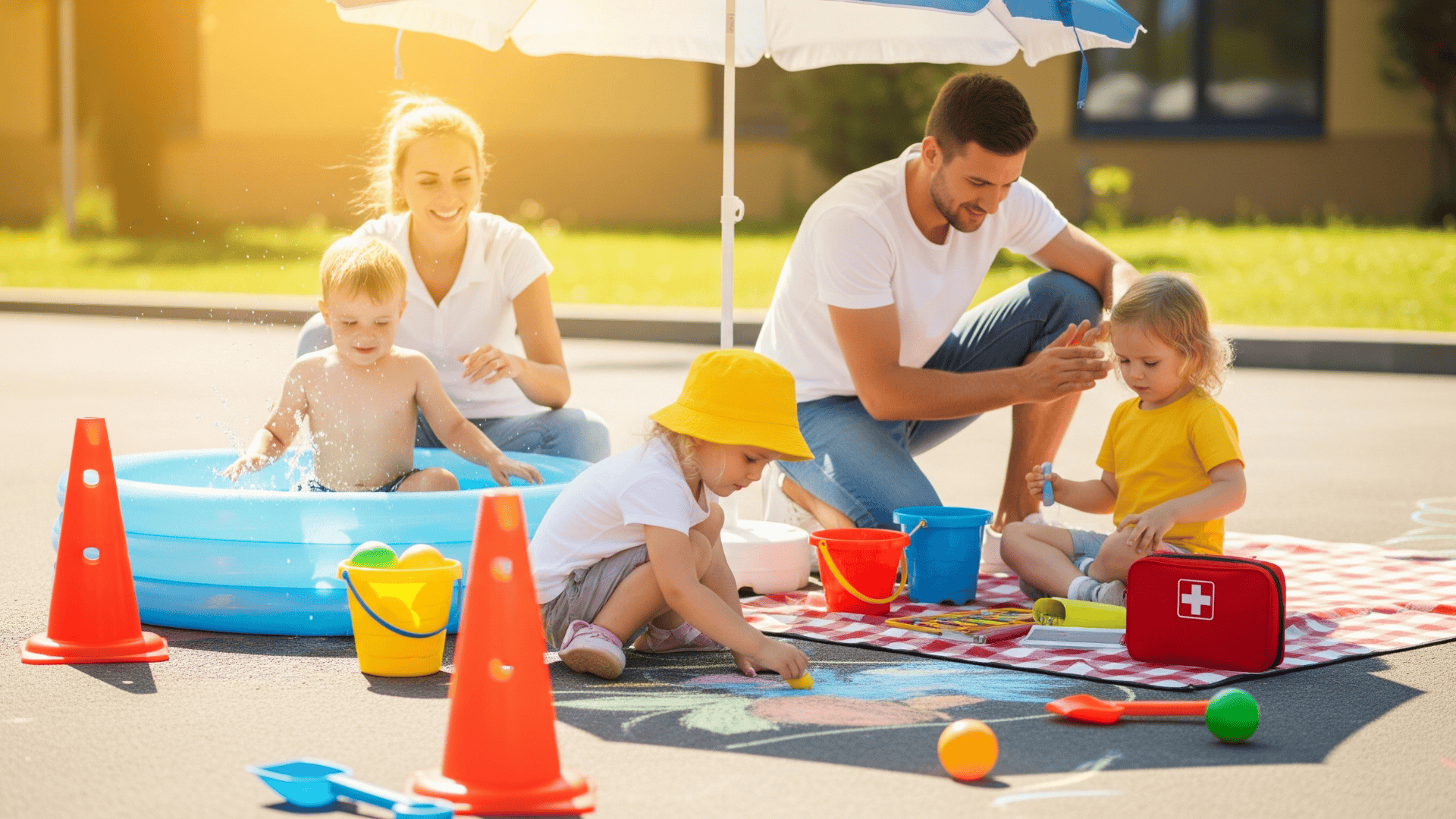
Putting safety first allows kids to explore and learn with confidence while reducing the risks that come with summer activities.
With proper safety measures in place, kids can focus on having fun while parents can relax knowing everyone’s protected.
These summer activities offer rich learning beyond entertainment, promoting holistic child development through play-based exploration.
Combining activity, creativity, science, and social interaction helps children develop skills, create memories outdoors, and form associations.
The variety helps children find activities that match their interests and needs, promoting new experiences and skill development.
These projects demonstrate that meaningful learning naturally happens through active, hands-on activities that foster children’s curiosity and creativity.
If you’re interested in more informational content, feel free toand research other blogs that you might enjoy.












